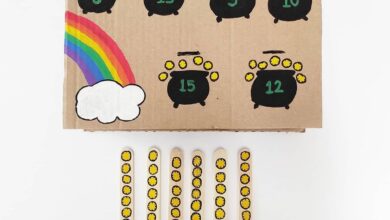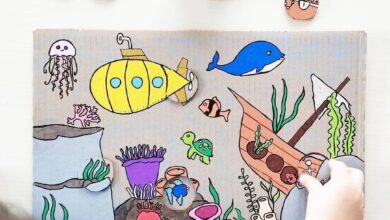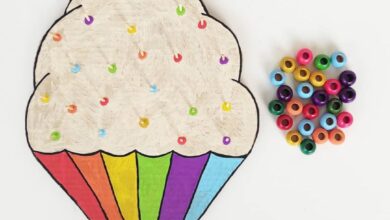60 Activities 60 Games At Home For Kids
Preschool and Homeschool Games and Activities
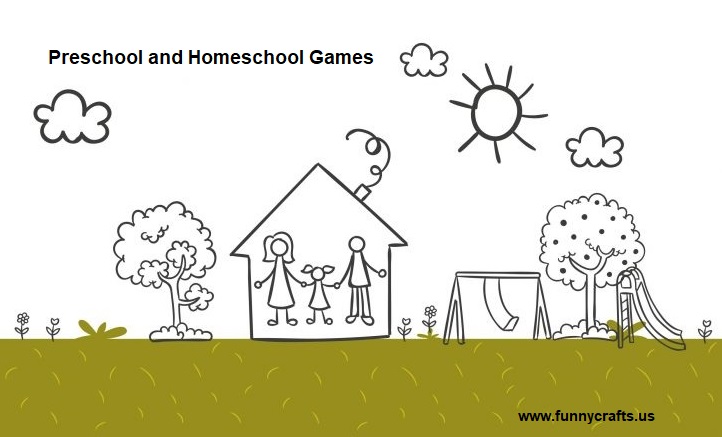
You can find in this essay the working pages of 60 Activities and 60 Games prepared by Tokat Provincial Directorate of National Education on the theme of “having fun and learning at home”. Also, be sure to read our article including 60 game suggestions that we added before and that has been read by thousands of people.
Having Fun and Learning at Home
A great guide to educational material including 60 Activities and 60 Fun Games is prepared for preschool, primary school, secondary school and highschool education levels. These materials will help you in terms of enhancing the acquisitions of various lessons and of developing your skills and talents. We are grateful to our teacher, Tokat Provincial Director of National Education Mr. Murat Küçükali and his distinguished employees, for their contributions to the creation of all these studies. For further studies, you can view the website of Provincial Directorate of National Education.
- What did I draw?
Draw whatever you want. Turn the paper backwards or fold it so that what you drew cannot be seen. Give clues to your children about the drawing. For example, is it an animal, a plant or food? If they know, it is their turn to draw and ask.
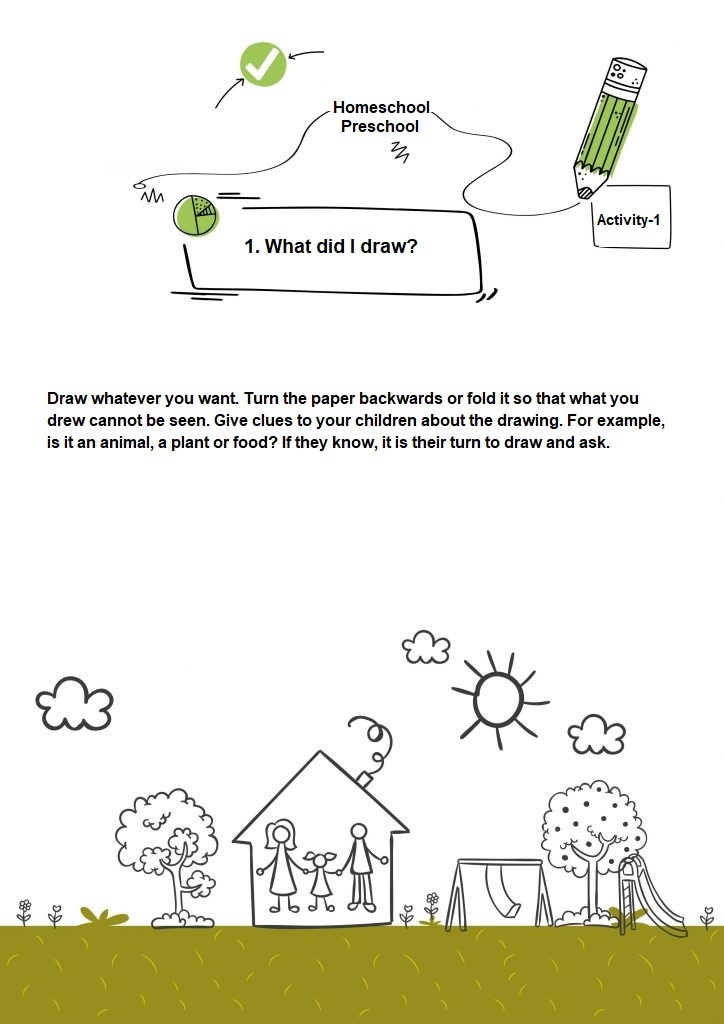
- Create New Words
Play a word game by creating a new word starting with the last letter of the word that you chose. For instance: flower > ring > grape > eyebrow…
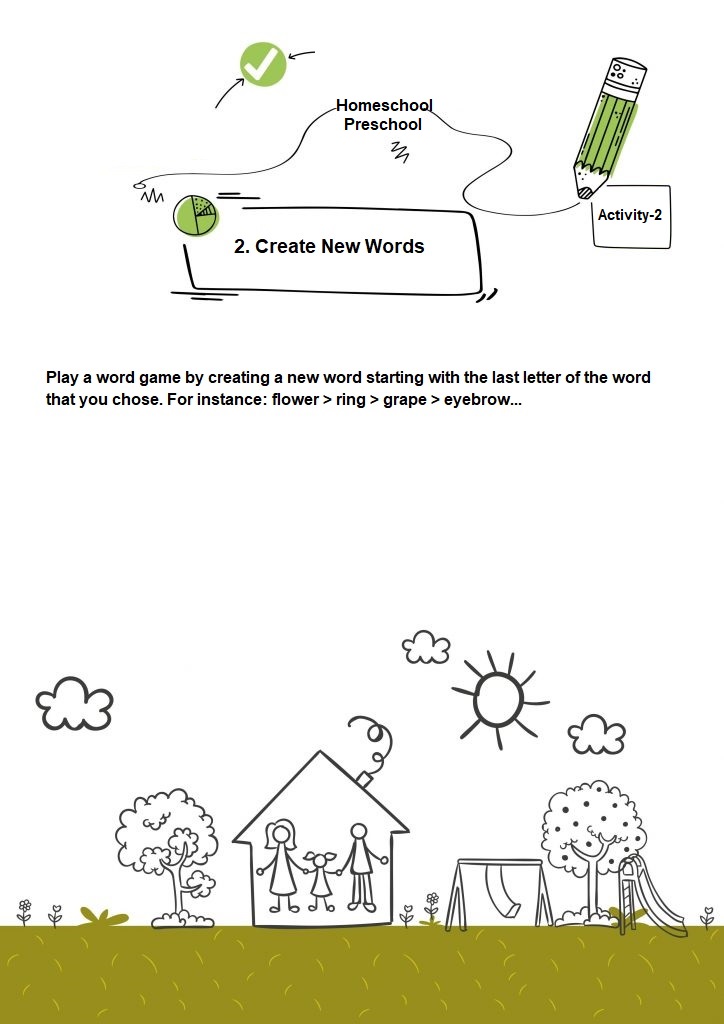
- Attention Please!
Purpose of this game is to create a story with children. For this, the child is asked to select a place, time and a character. He may say “at home”, “in winter/summer”, or “character will be a lion”. Then the adult begins a story including these. Child is required to follow the story cautiously. At the end of the story, it is said that some questions about the topic are going to be asked and correct answers must be given. The adult, enters the story with the place, time and character selected by the child; “Once upon a time in summer, there is a lion living in a home,” for instance. Then the child continues the story. Time to time, the adult may add some contributons that would enrich the story, such as making the child name animals, places and adding new characters and colors. After a while, the story is being ended and questions are asked to children. For example, the number of the animals in the story if there is any, or colors of clothes. With this game, improving imagination and attention is aimed.

- I’m Giving an Interview
Imagine you are a journalist. Do an interview with your kid. Ask them questions such as “How does your one day passes?” or “What is your favorite song?”. Then let them ask you questions this time.
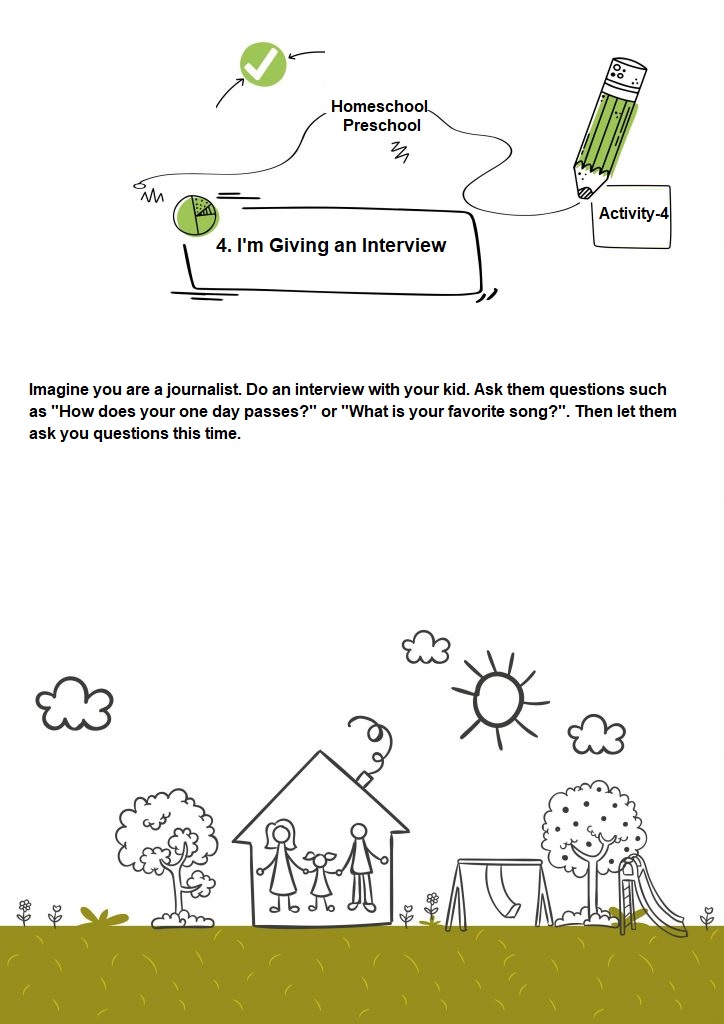
- Making Salt Ceramics
Mix up one cup of salt, one cup of water and two cups of flour and knead them. Then make salt ceramics with your children. Flatten the dough with your hands and press a leaf on it. You will see its traces. You can dry this dough and paint it.

- Frog on the Beach
Put a large cushion on the floor. Let’s say it’s sea. You child will bounce as if he is a frog. Say him to bounce upon the cushion if you say “Frog in the sea!” and to bounce outside the cushion if you say “Frog on the beach!”. Clap the one who continues the game without making a mistake.
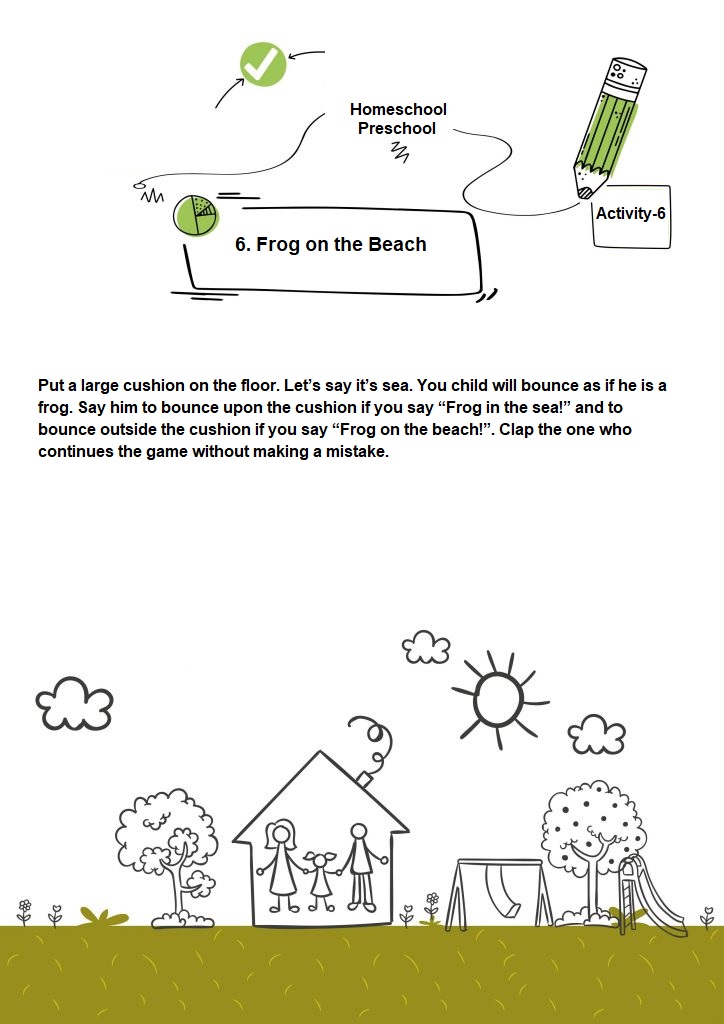
- Drawing a Sketch
Grab a measuring stick and measure the walls of the room. Then write down your measurements. Draw a sketch/plan of your house with your child by measuring windows, doors and furnitures.
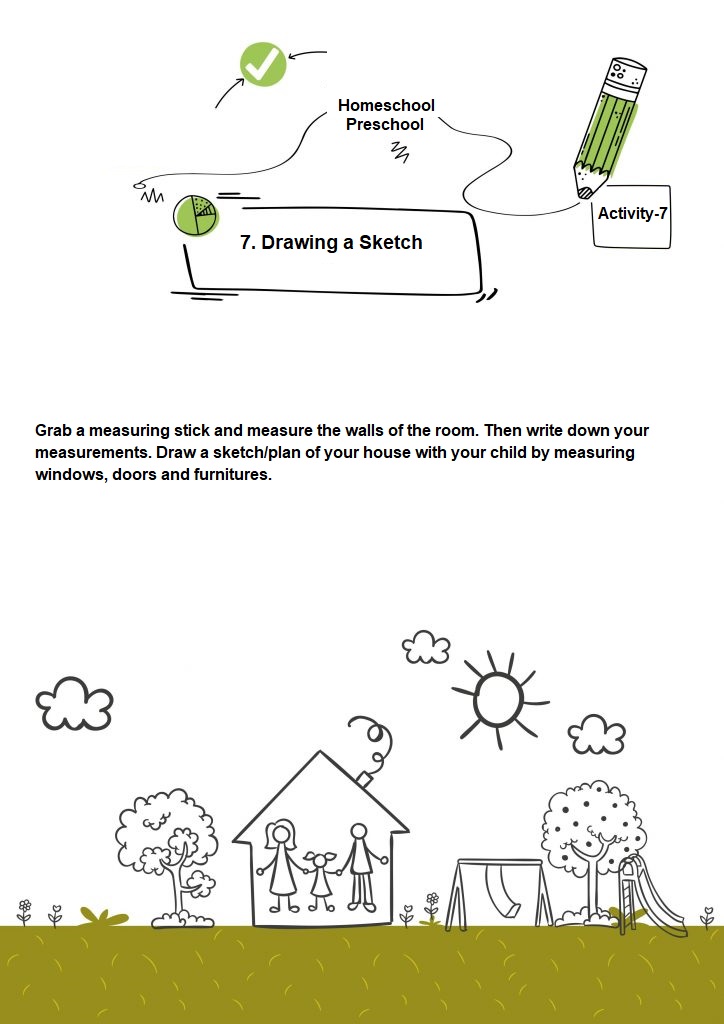
8.Shadows of the Objects
Create a shadow of toys upon a large white paper by using a light source (portable lamp, flashlight etc.). Ask your child to trace these shadows with a pencil. Then let him color the shapes he has drawn.
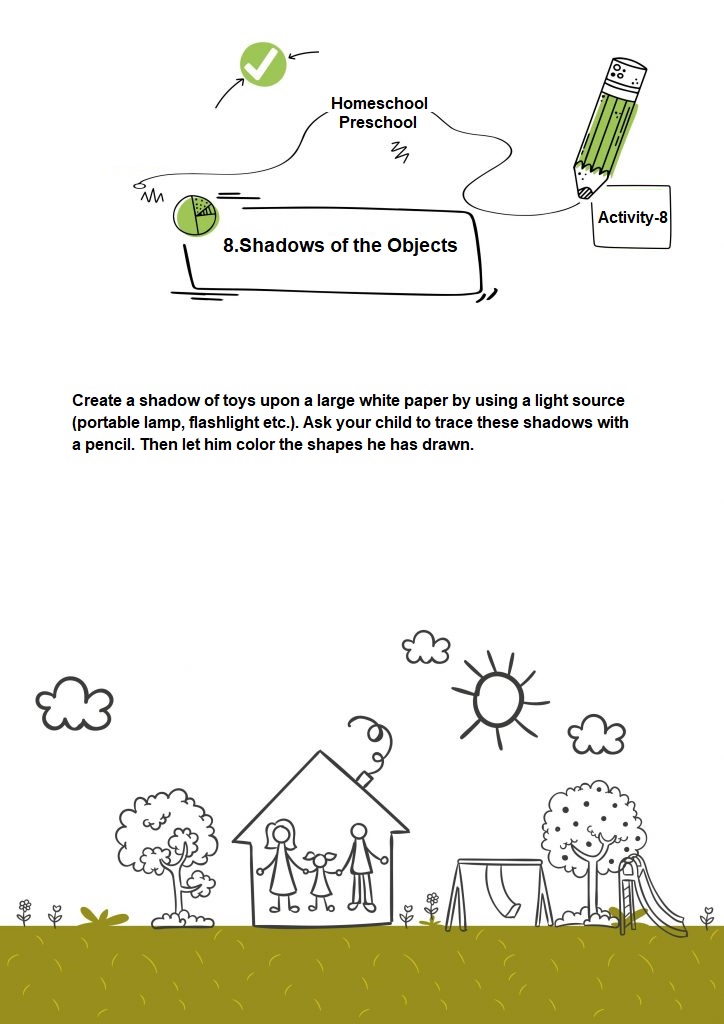
- Measuring our Heights
Mark the heights of family members on a wall or a door. Make sure they are side by side and emphasize the differences. Repeat this measurements once every three months and follow the process of your child’s increase in length.
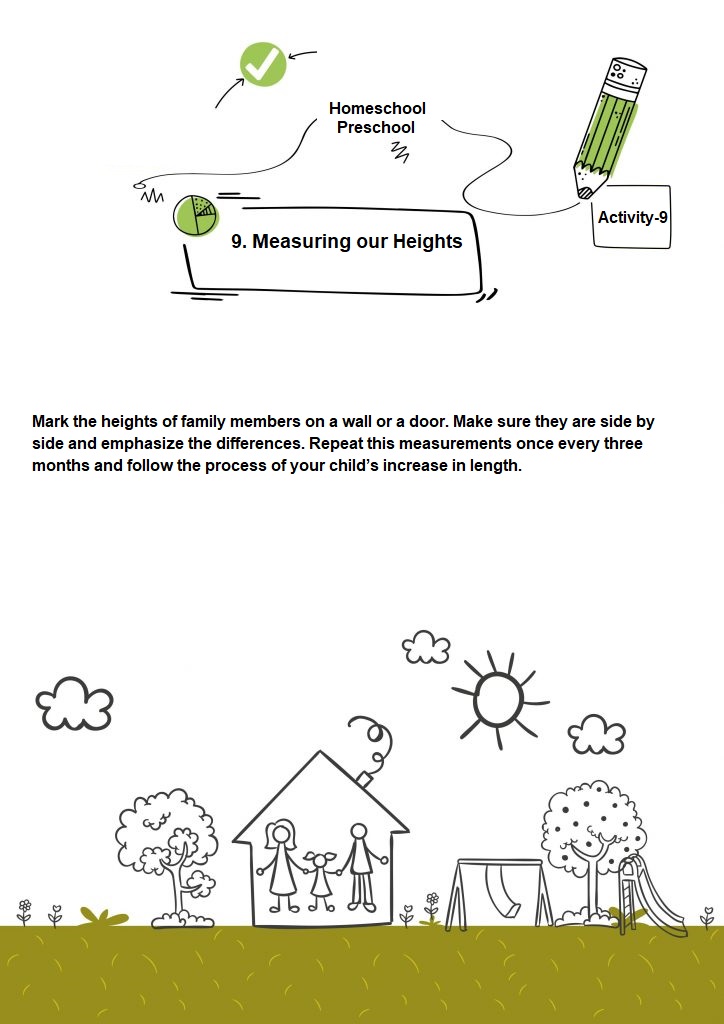
- Complete the Picture
Lay down a large paper on the floor. Lay your child or one of the family members down upon this paper and draw their silhouette by tracing the outlines. Complete the details (eye, eyebrow, hair, nose) with your child or family members.
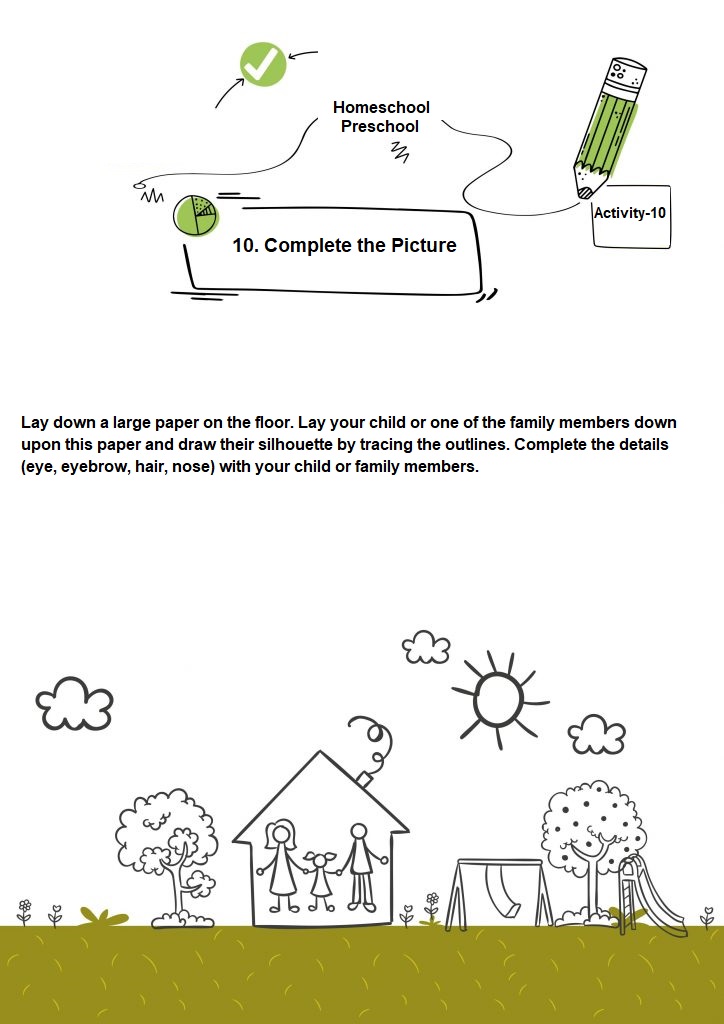
- Making our Own Paints
Take a nature trip with your family. Collect leaves of different colors, put them into a mortar and crush them. Color your drawings by paints you have made.
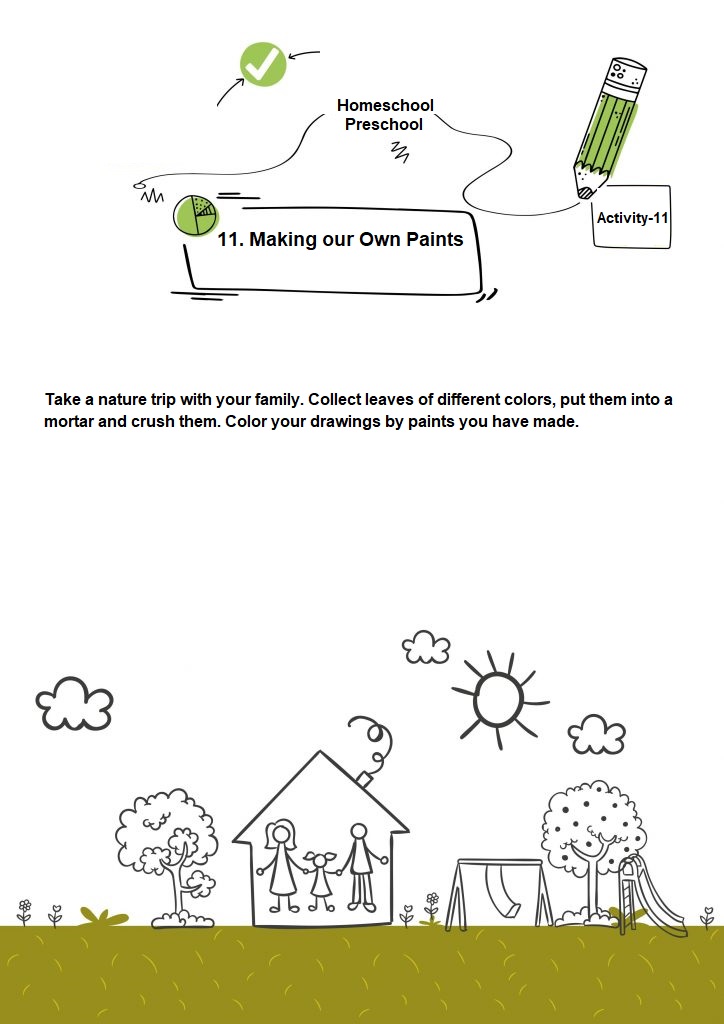
- Toy Store
Line up the toys and build a toy store. Write down the prices of toys upon them. Make family members act like customers and child as the owner. Play together a shopping game.
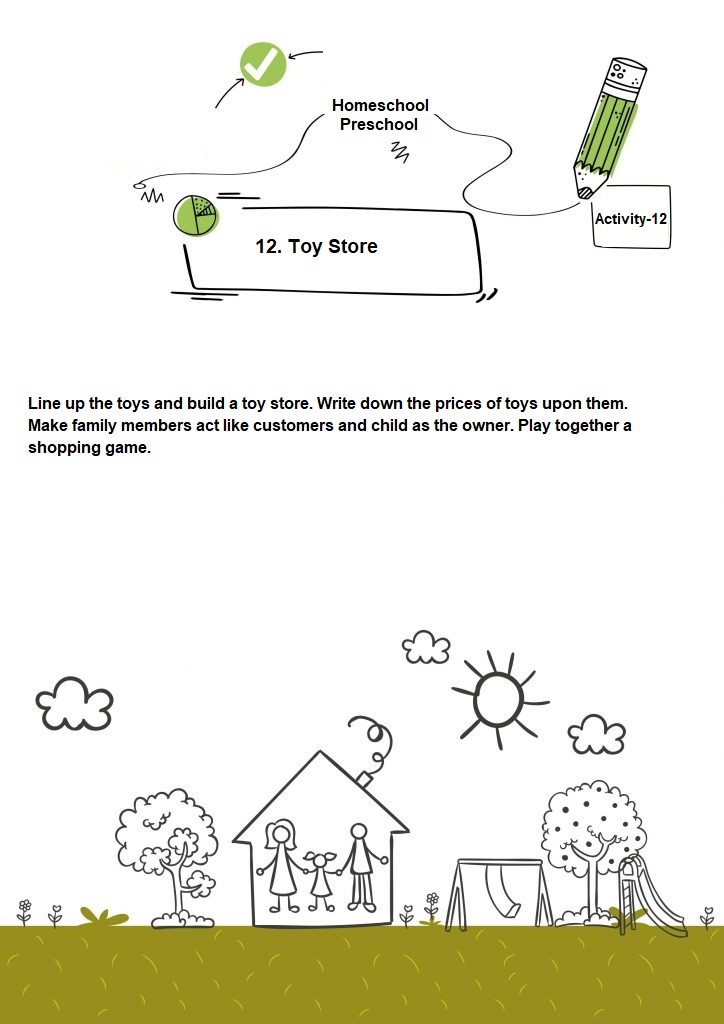
- Don’t Drop the Balloon
Blow up a balloon and play a “don’t drop the balloon” game with family. Keep the balloon on the air by hitting with your hands. Then play this by using only one finger. Then put your arms into your sweatshirt and keep playing with your head without using your arms.
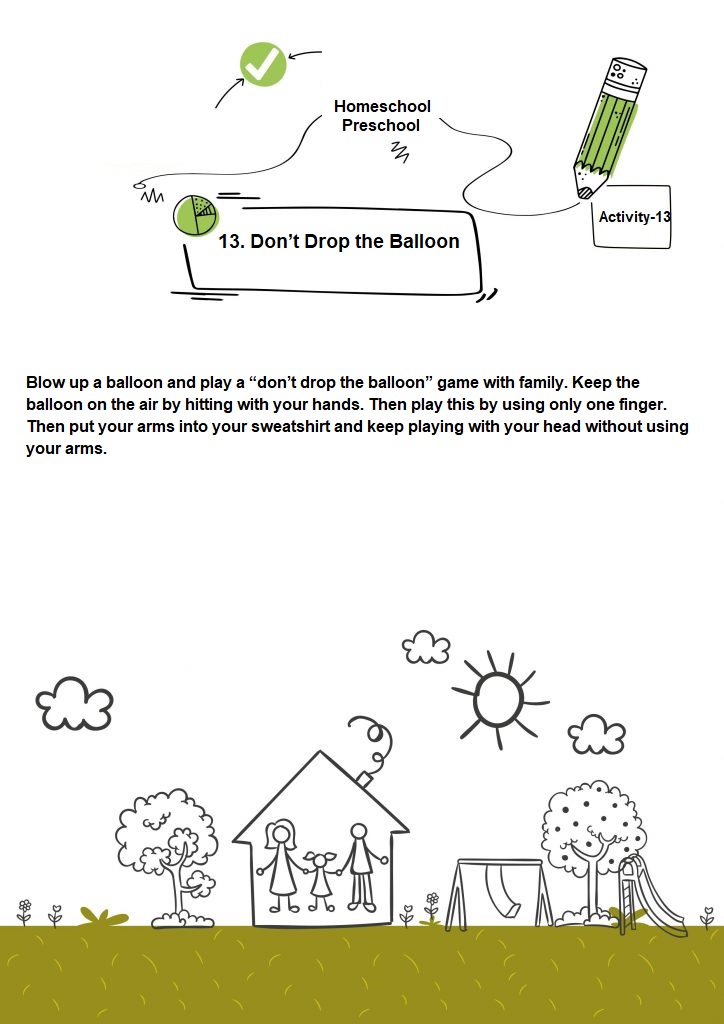
- Painting Rocks
Draw shapes (house, car, bird, flower…) on the rocks you have collected from street. Select 3 of the rocks. Tell a story including these 3 words. Enrich the story with your imagination. Click to view painting rock activity I have done with my daughter.
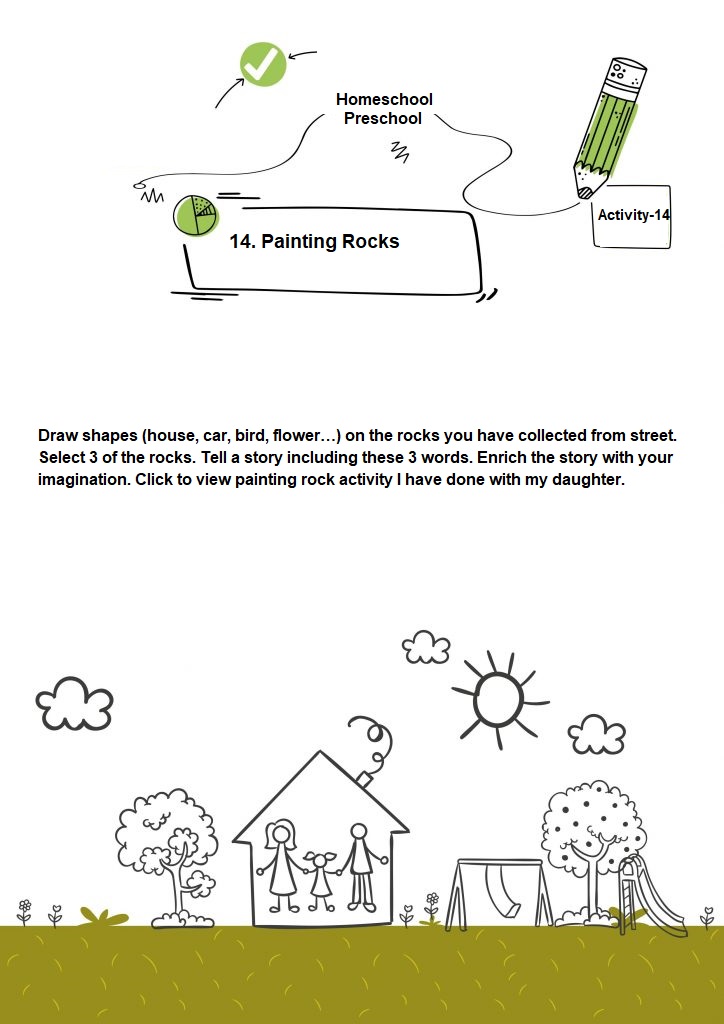
- Morning Sport
Do morning sport with your family in order of breathing exercises, head, neck, arm, back and leg movements… Activate your whole body.
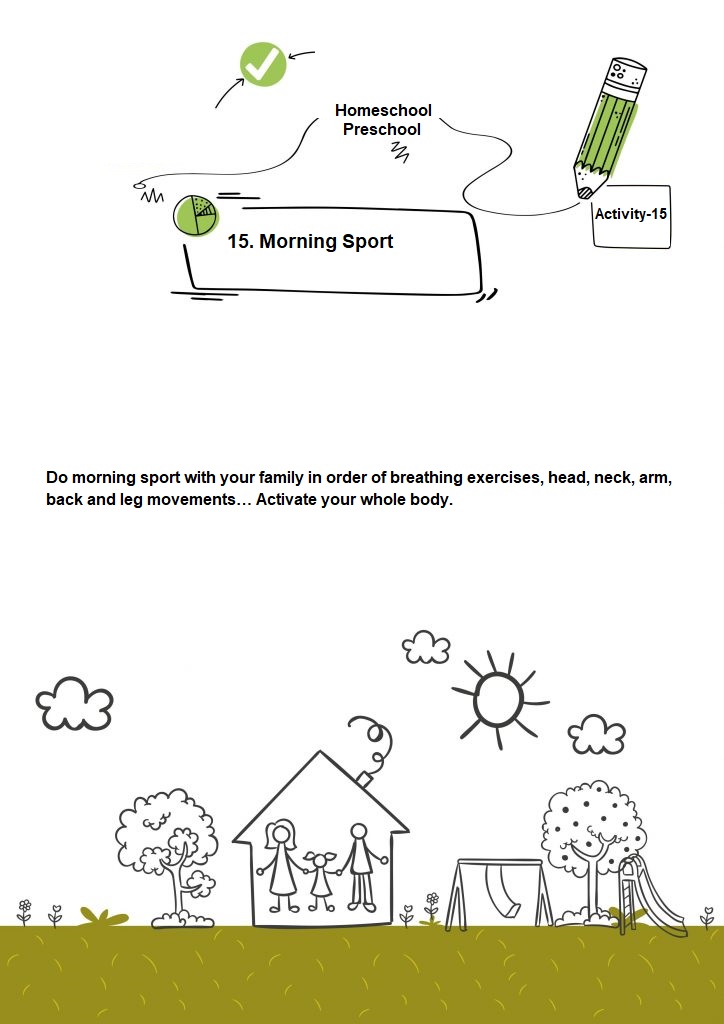
- Draw with Legumes
Go to the kitchen, grab some legumes such as beans, pasta, corns, chickpeas and pour them on the table. Create shapes and pictures with your children by using these materials. Click to view other art activities with legumes.
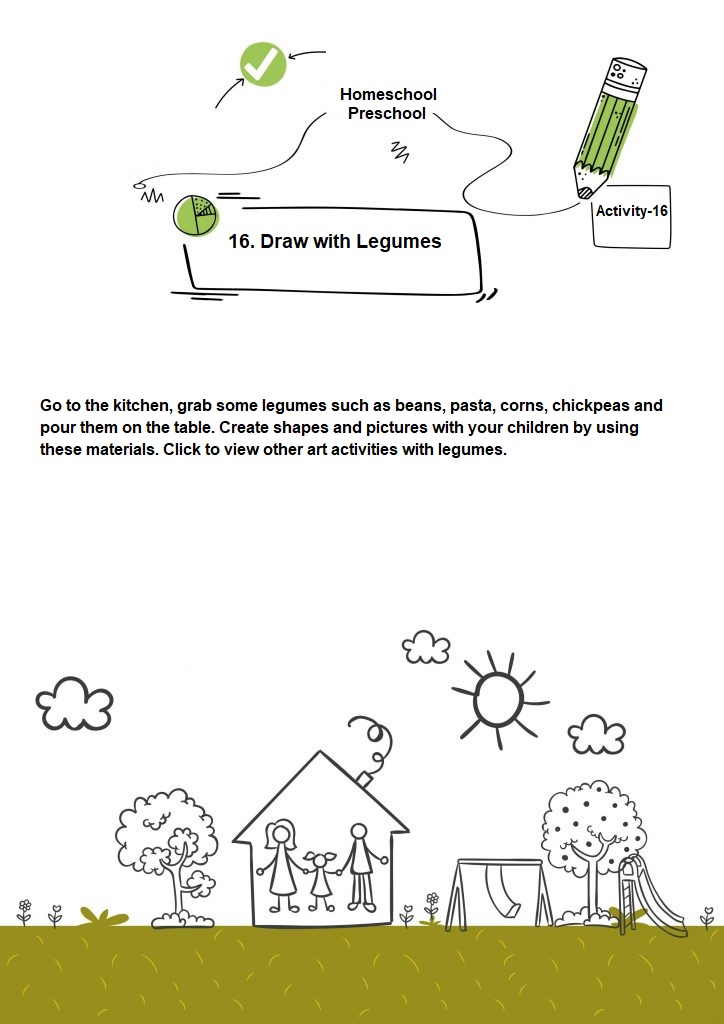
- What’s This?
Grab a cardboard box that is large enough for your child to hide behind. Cut out a piece from the front face of box and make a window. Let your child, hiding behind the box, put their arms out of this window. Make them guess the objects you put in front of them by touching.
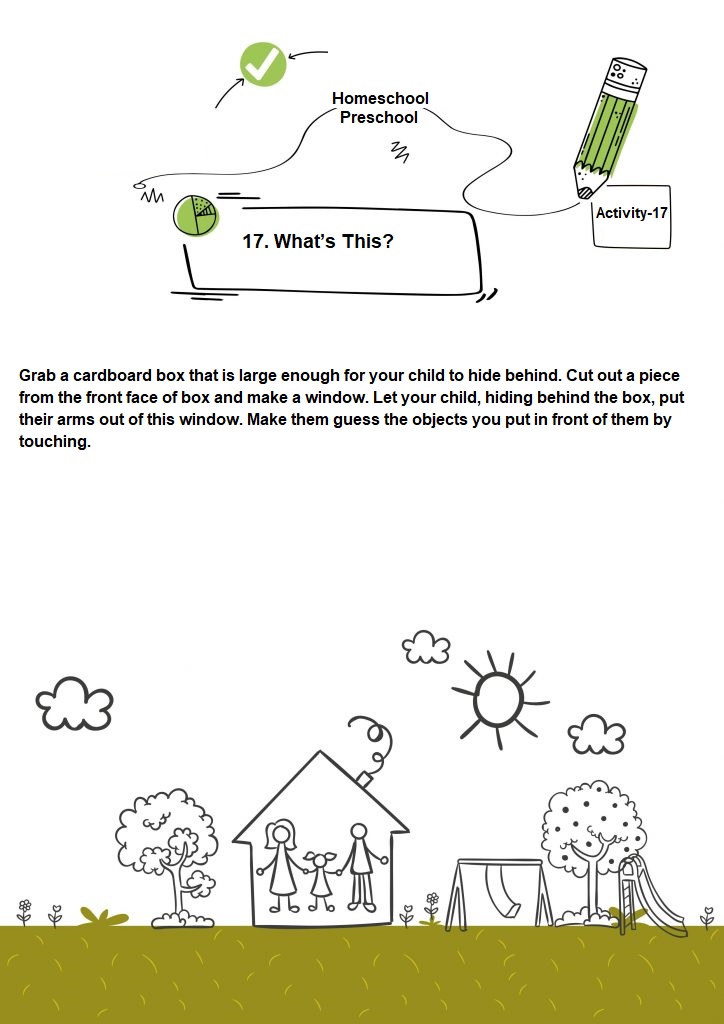
- Crown Cap
Draw a circle on the ground with a piece of chalk. Make a curved and long path following the circle. Put a crown cap at the end of the path. Try to move it forward by hitting with your finger. The one who first make it reach to the circle is winner.
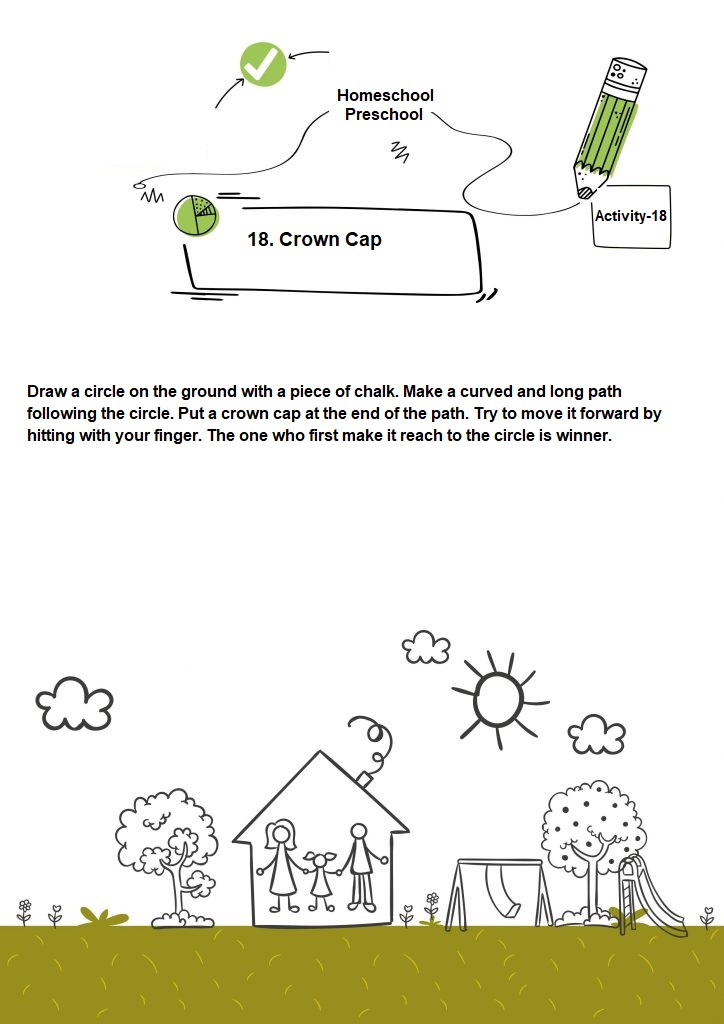
- Balloon Game
Stand face to face with your child, put a balloon or a ball between your bellies and squeeze it. Without touching anywhere and falling it, try to walk. It would be funnier to mark a starting and a finishing line.
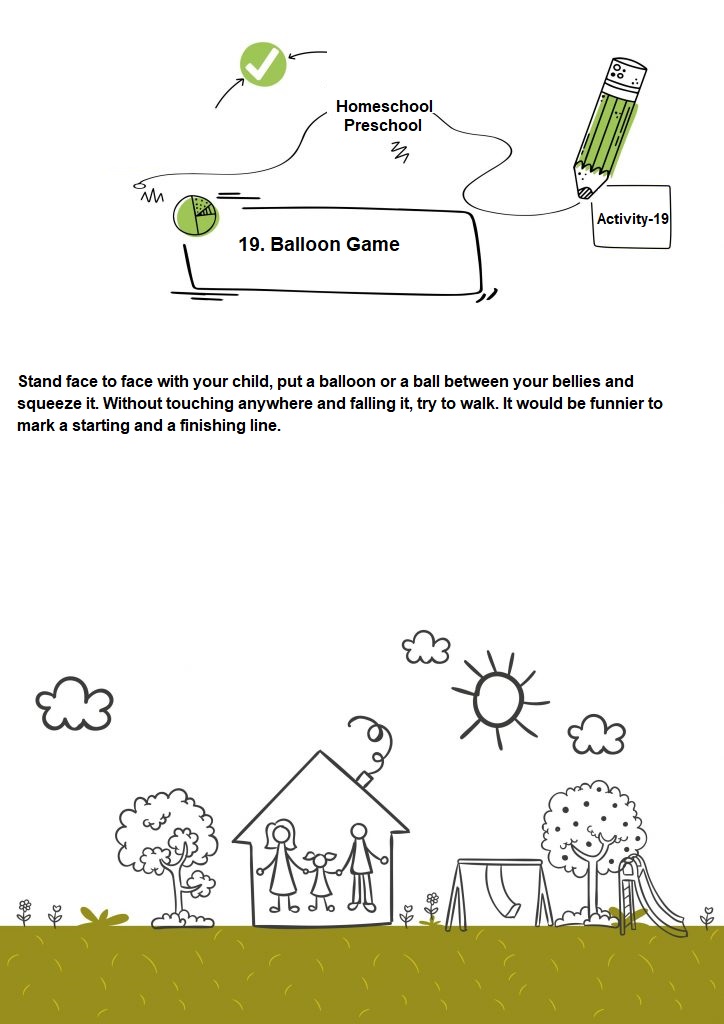
- Tipcat
Go outside as a family. Find two stones and two sticks, one short and one long. Put the short one on stones as if it’s a bridge. Hit the bridge with long stick. Play tipcat by making it get off the ground.
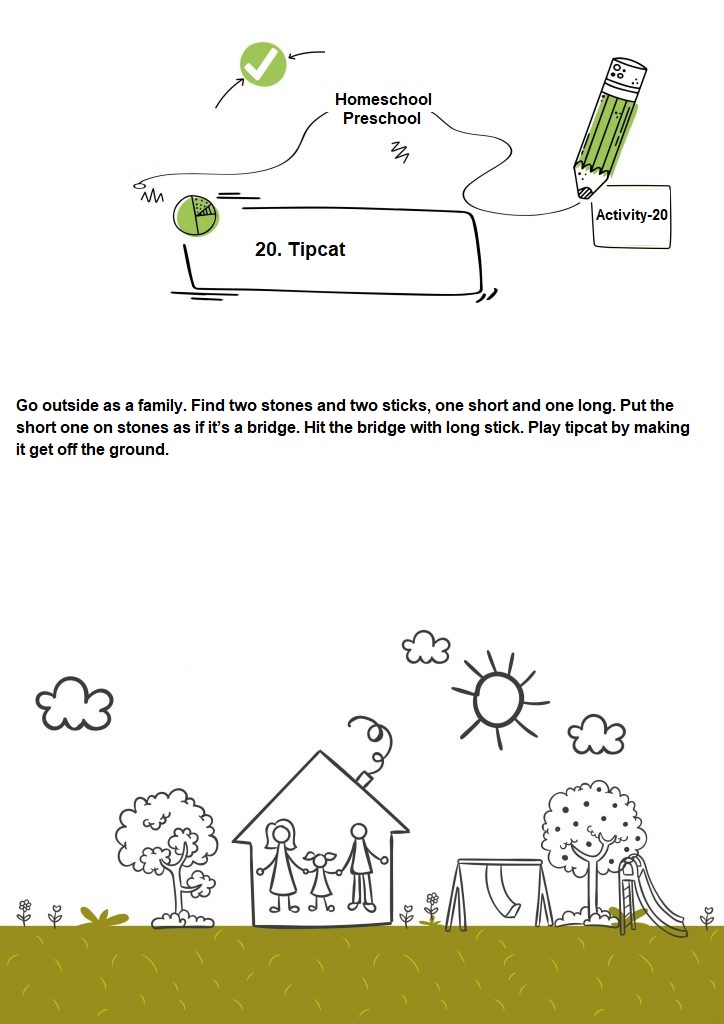
- It’s Your Turn
Cover a square pillbox with a colored paper like a gift wrap. Write down an activity on each surface. For example; jump, sing a song, laugh, tumble, turn around yourself ten times, tell a fairytale etc. Throw the pillbox in turn and follow the directives that show up. Clap each other.

- Taste and Guess Right!
Ask your kid to close their eyes and have them taste different tastes such as lemon, sugar, salt, apple, grape, tomato paste etc. Ask them to guess the food.
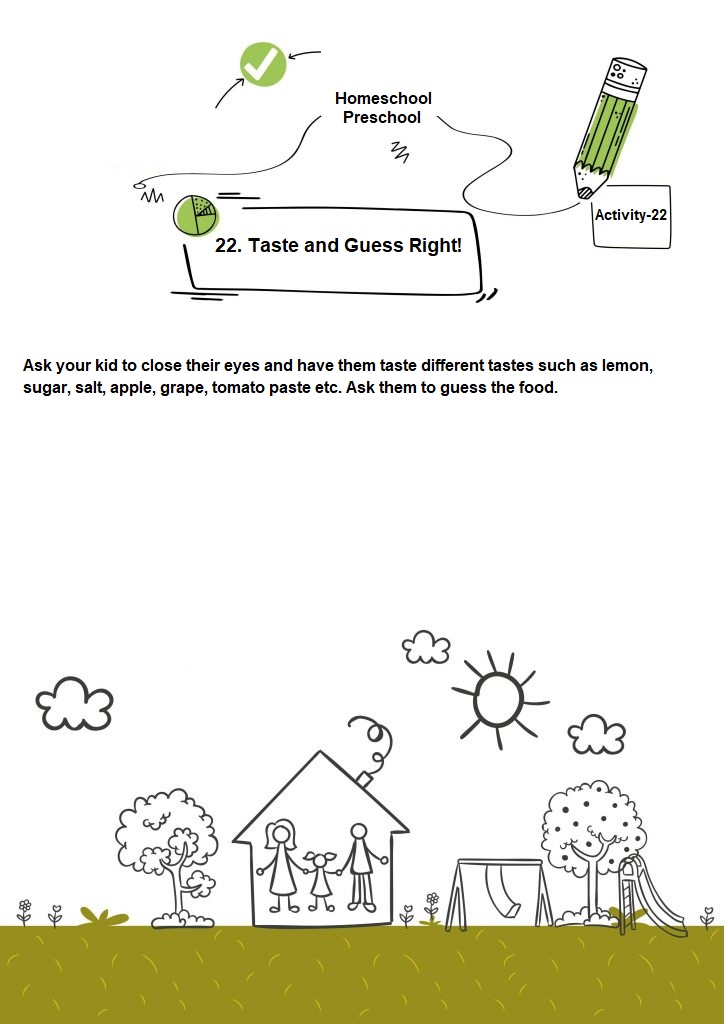
- Key
Buy some keys and padlocks to home. Shuffle locks and keys. Ask your child to find out which key belongs to which lock by trying to unlock them.
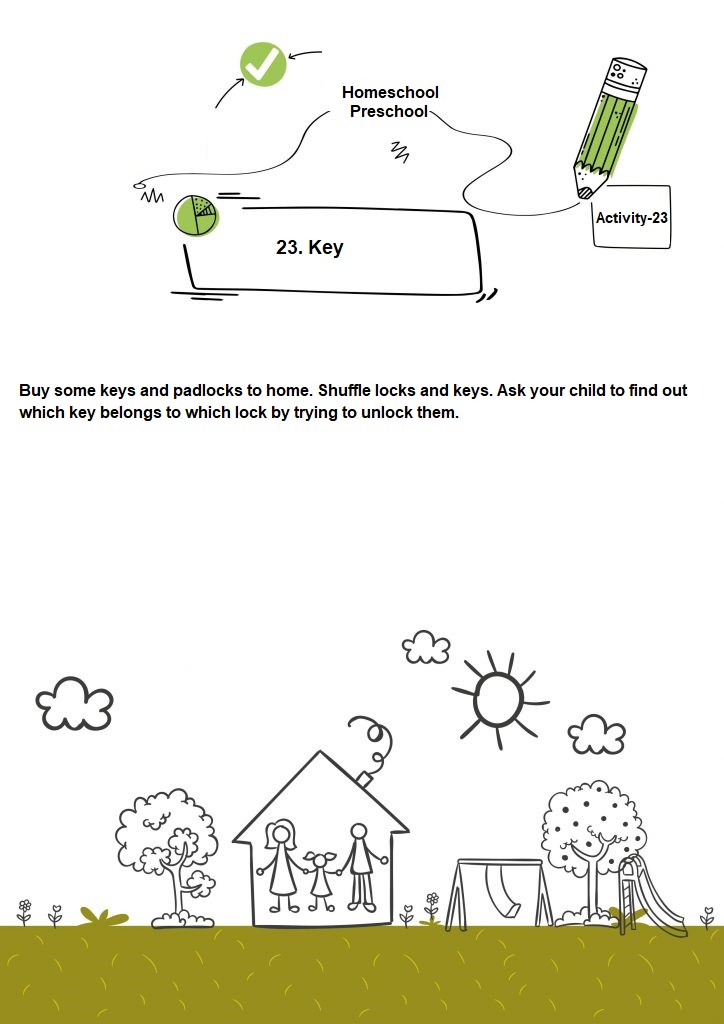
- Yes, No
One of the players is the one asking questions and the other is the one answering them. The answerer must not answer any question with “YES” or “NO”. For example, if he says “Yes” to the question “Do you go to school?”, he is out. “I do” he should say. The other player tries to make him say “Yes” by asking loaded questions as “How many brothers and sisters do you have? You have 3, haven’t you?”. The purpose of this game is to improve attention and quick thinking.
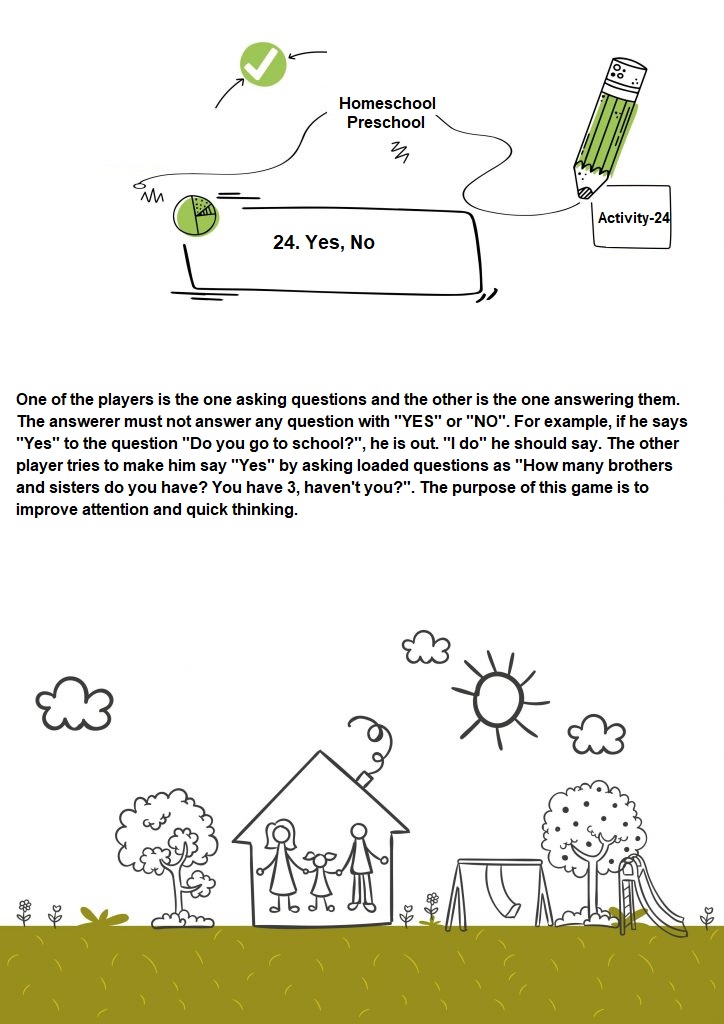
- Jackstone
Five stones are spread on the ground and one out of five is selected. Selected stone is tossed up with one hand only, and before it falls to the ground, other stones are grabed from the ground by increasing one number each. If the stone you tossed falls to the ground, the turn passes to the other player.
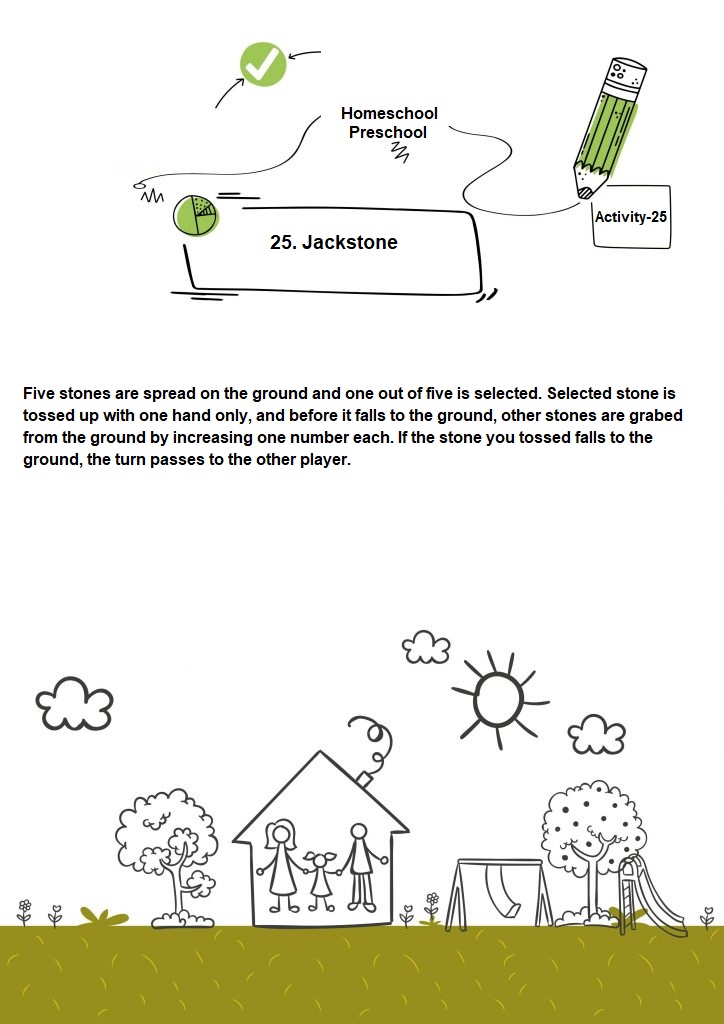
- Sounds in Nature
Put the toys of your child into a bag. Ask him to pick an animal out of the bag, to name it and to imitate the sound it makes. In the second step, you can ask him to give more information about that animal.
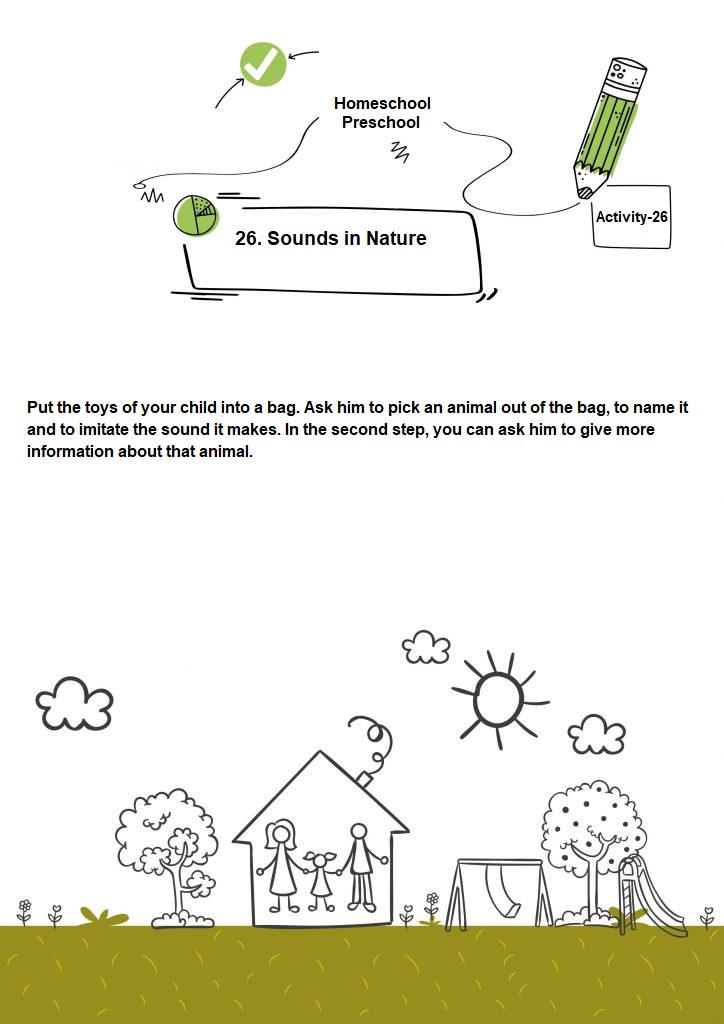
- Side by Side
Play a game of finding things standing side by side. What things are next to ach other at home, on streets, everywhere? Say it out loud in order. Trees, buildings, fingers… This is an effective game in terms of understanding spatial relationships and improving observation skills.
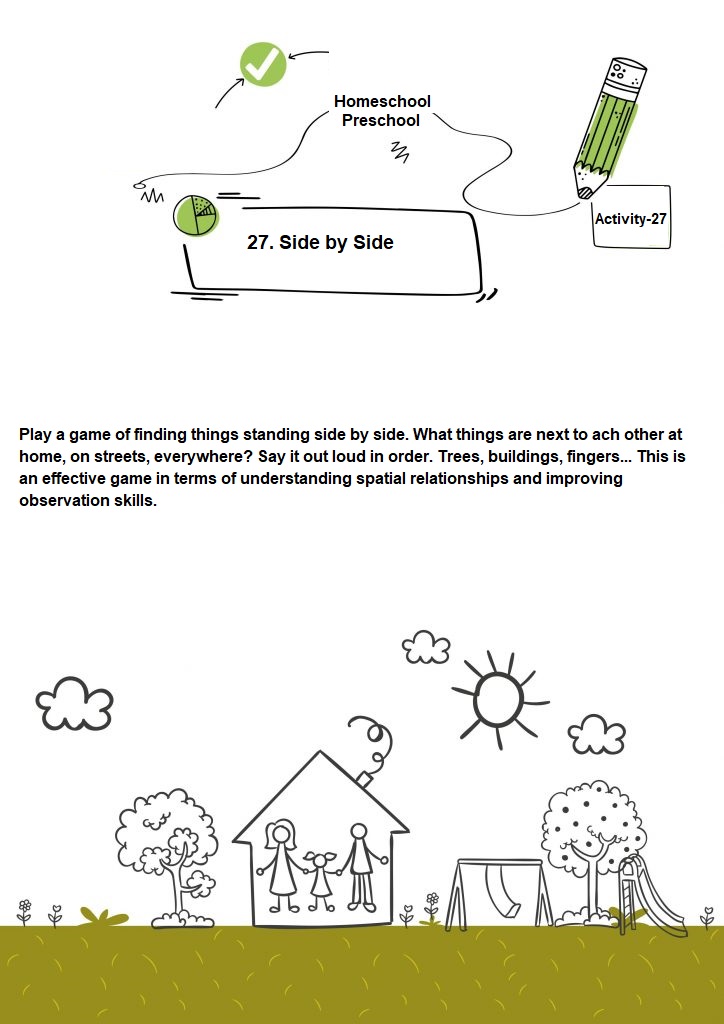
- Untie It If You Can
C’mon, it is time to tie a knot and untie it! Tie a knot to chair’s leg or doorhandle by using materials such as a piece of cloth, shawl, ribbon, rope. Play a game of tying and untying.
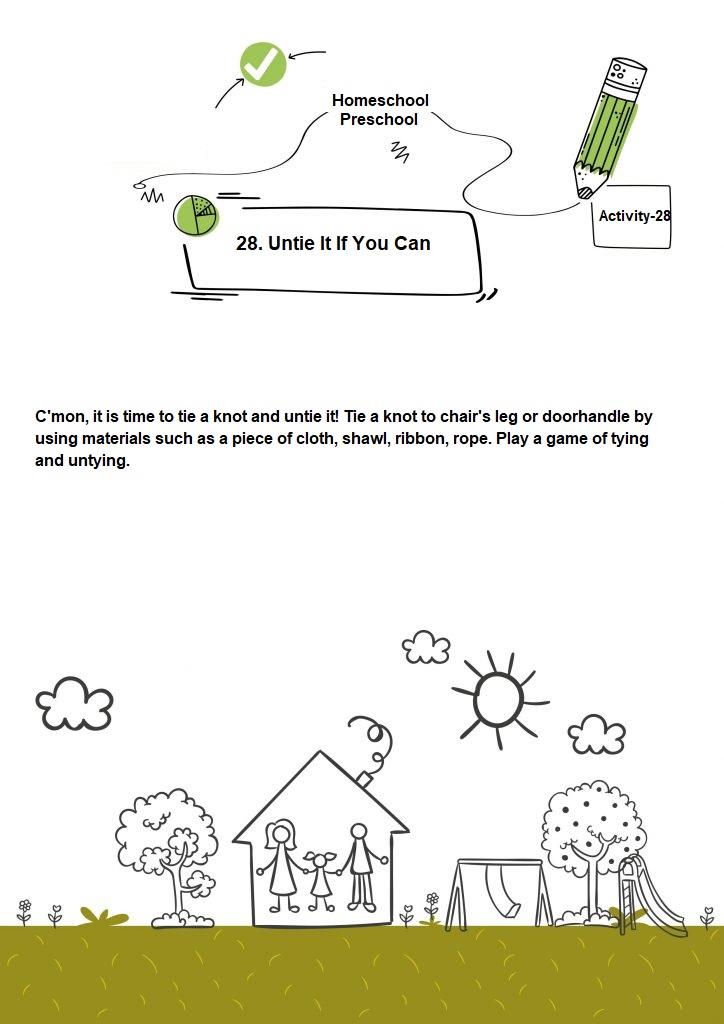
- Lost Object
Put five different objects in front of your child. Ask them to close their eyes and take out one of them. Ask again for them to guess the object. You can increase the number of objects as the game progresses.
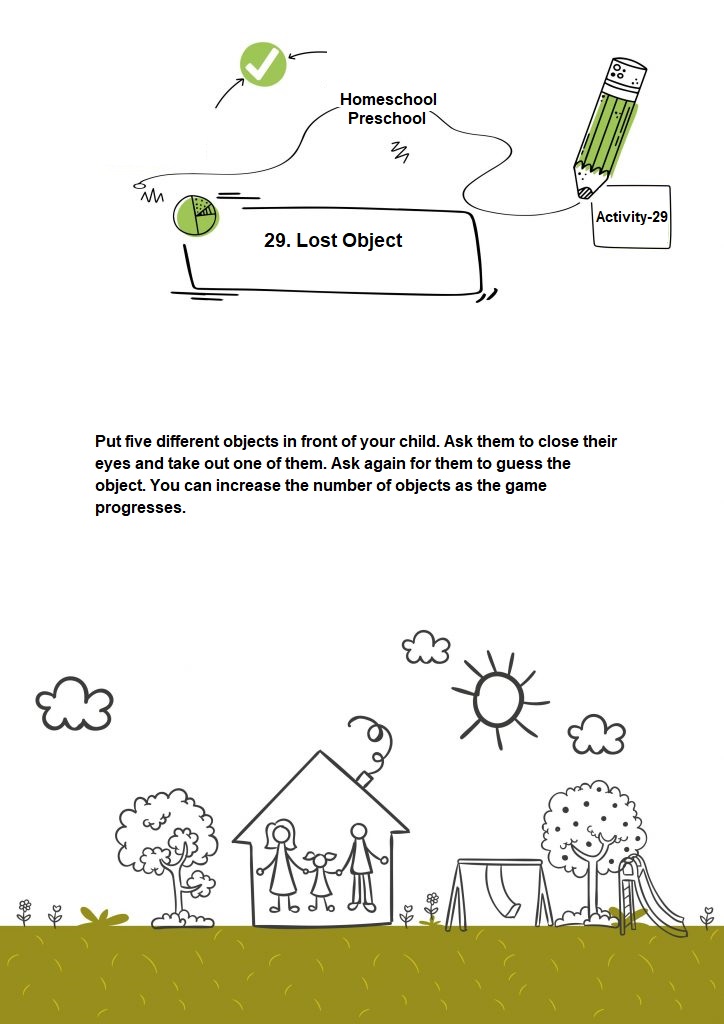
- Making Clay Dough
Make a clay dough with your child. Add water to two glasses of clay in a controlled manner. Knead a soft dough not sticking to the hand. Your clay dough is ready. Shape the dough as you wish by pretending as if you are a sculptor.
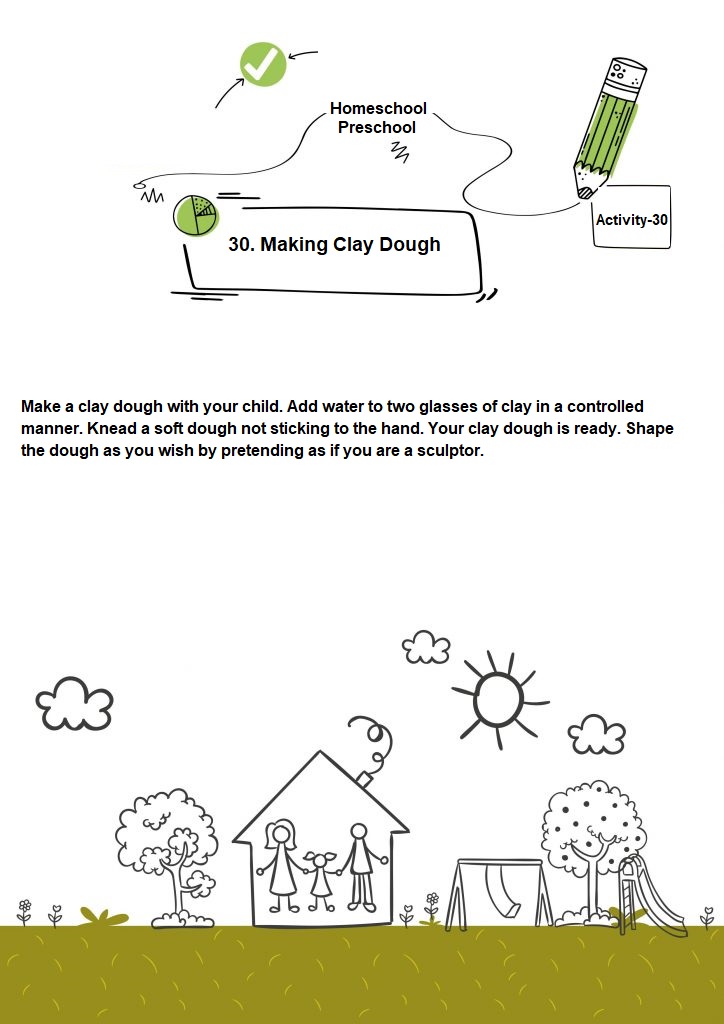
- Balance Game
Are you ready to play balance game? First, stand on one leg and count to five. Then jump three times on where you are on one leg Go from one room to another by jumping with one leg only.
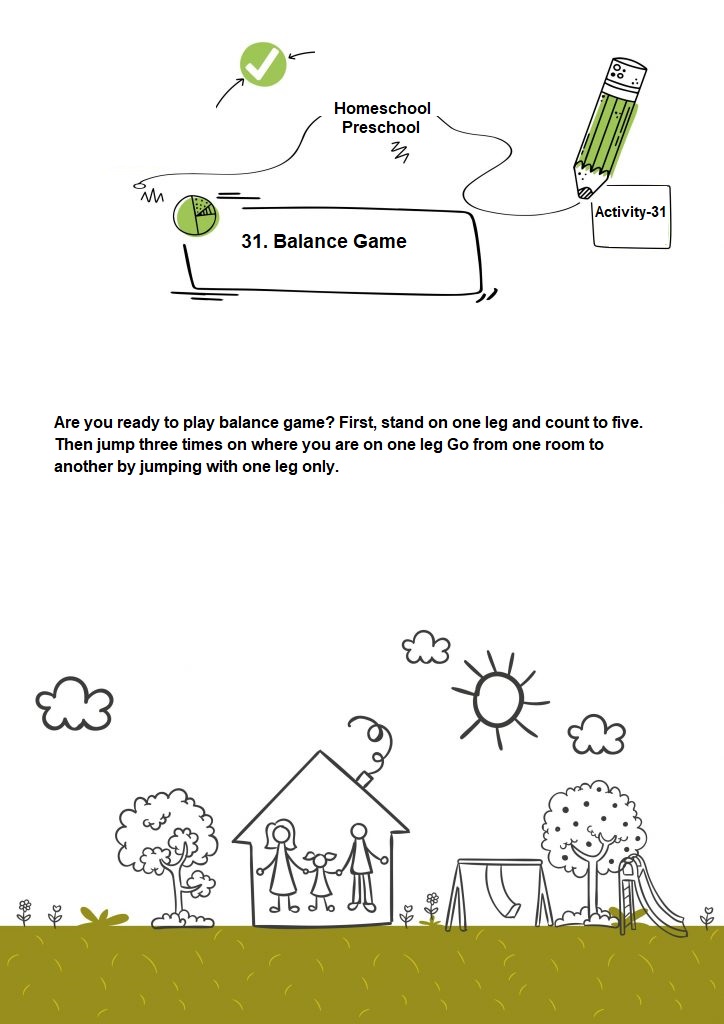
- Get to Know Spices in the Kitchen
Look for the spices in the kitchen with your child. Draw their attention to the spices of different color, smell and shape. Explain how many of them are made from plants. Tell what spice it is and where to use it by smelling it.
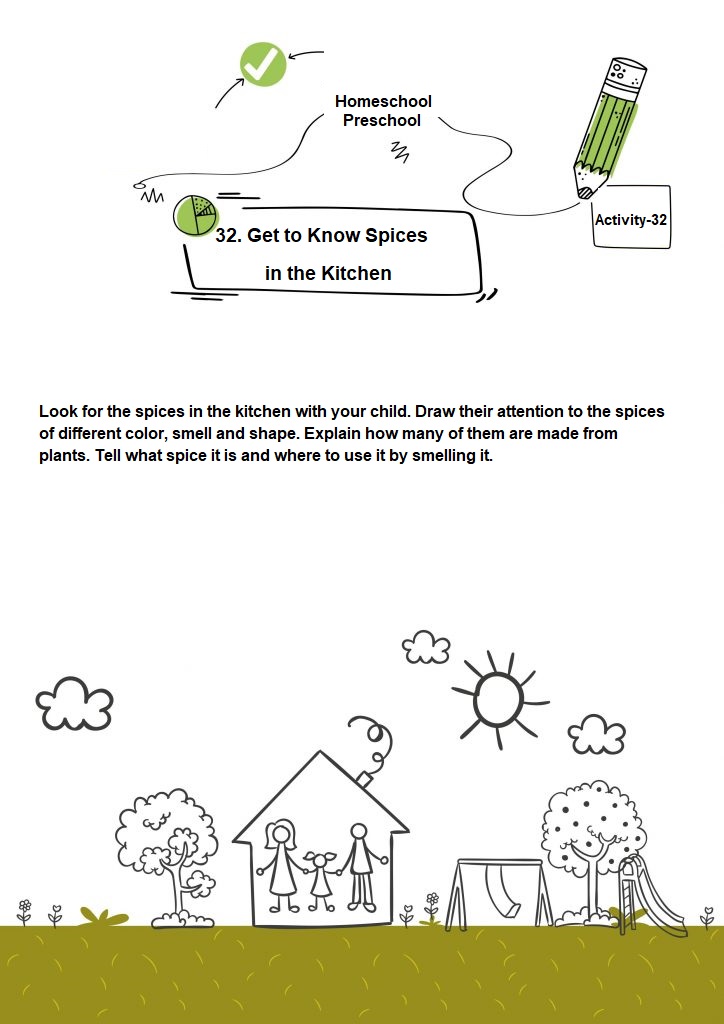
- Plan Our Day
Plan that day with your child. Write down the ideas that came up to your mind while planning and follow these throughout the day. This will contribute to the development of a regular lifestyle for your child.
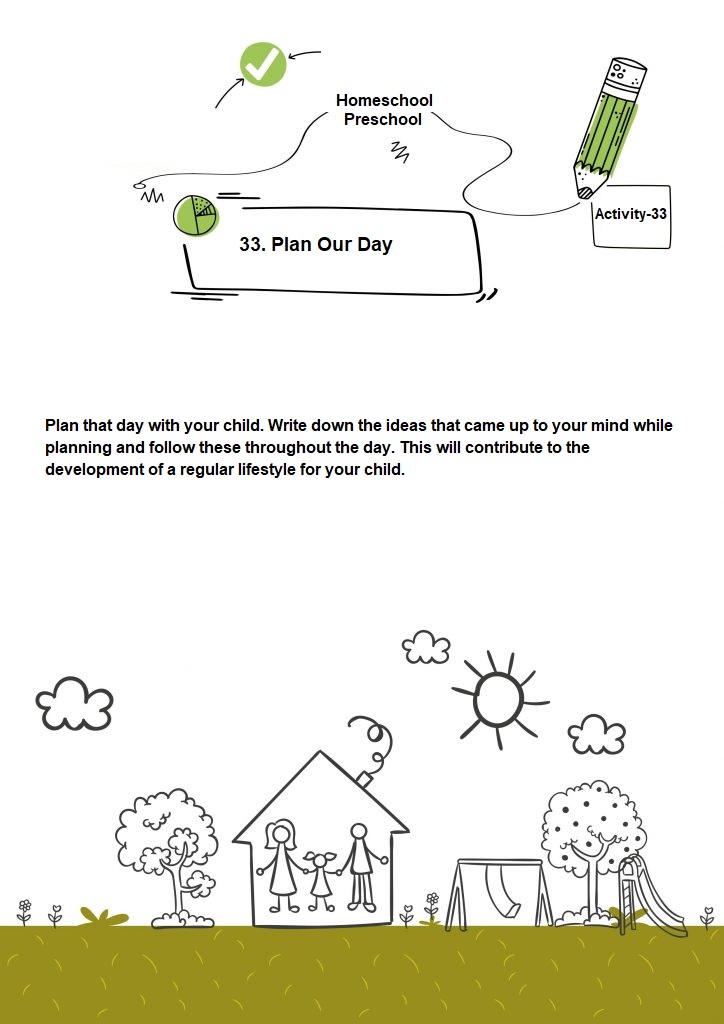
- Without Falling the Balloon
Try to walk by keeping a balloon between your legs. It is important in terms of physical development for your child to try not to fall the balloon and to keep the balance while walking. For you, it would be very fun.
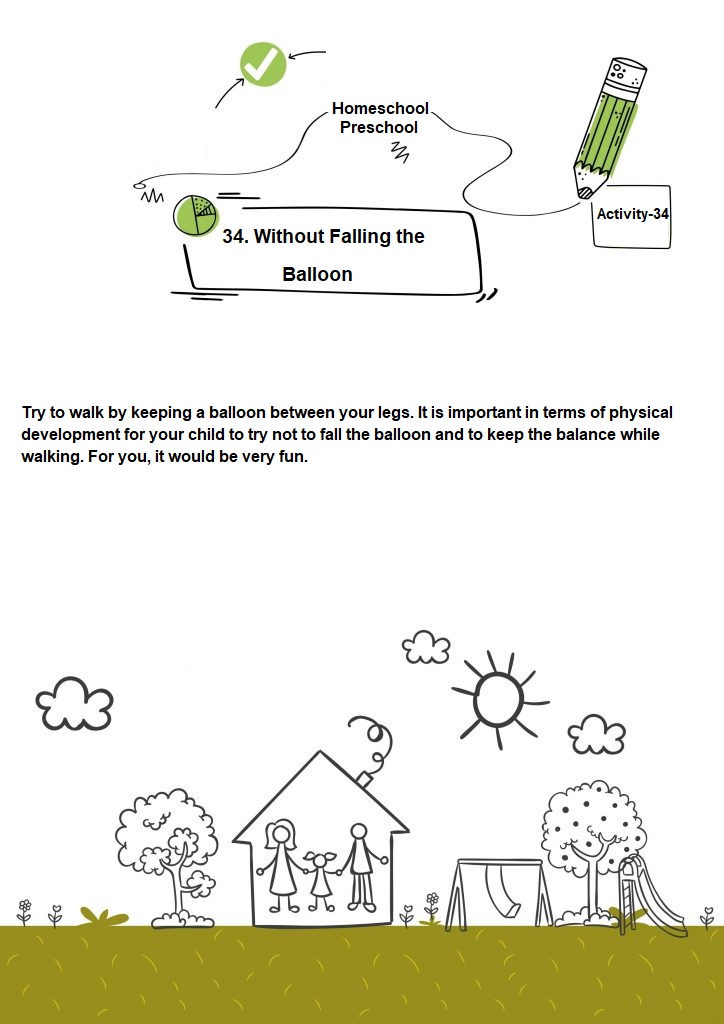
- Let’s Find Cities on USA Map
Go over the USA map and point out the cities on map. Talk about the characteristics of the city you are pointing. You can do the same activity on world map too.
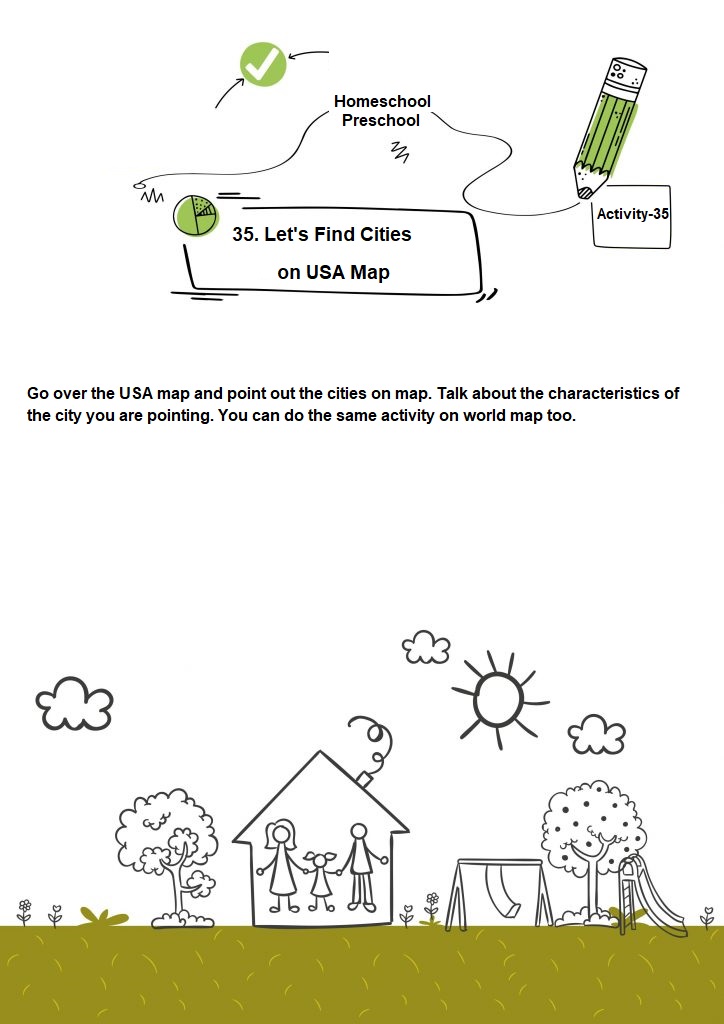
- Babies of the Animals
Do you know the babies of the animals? Ask your child to name the baby of the animals such as lamb, goat, cow, horse, dog, donkey, cat, chicken, buffalo. Then, ask them to create an album of these by cutting their pictures out they would find from magazines and newspapers. Thus, it is aimed to contribute to the plantation of love for animals in children and to the development of their hand skills.
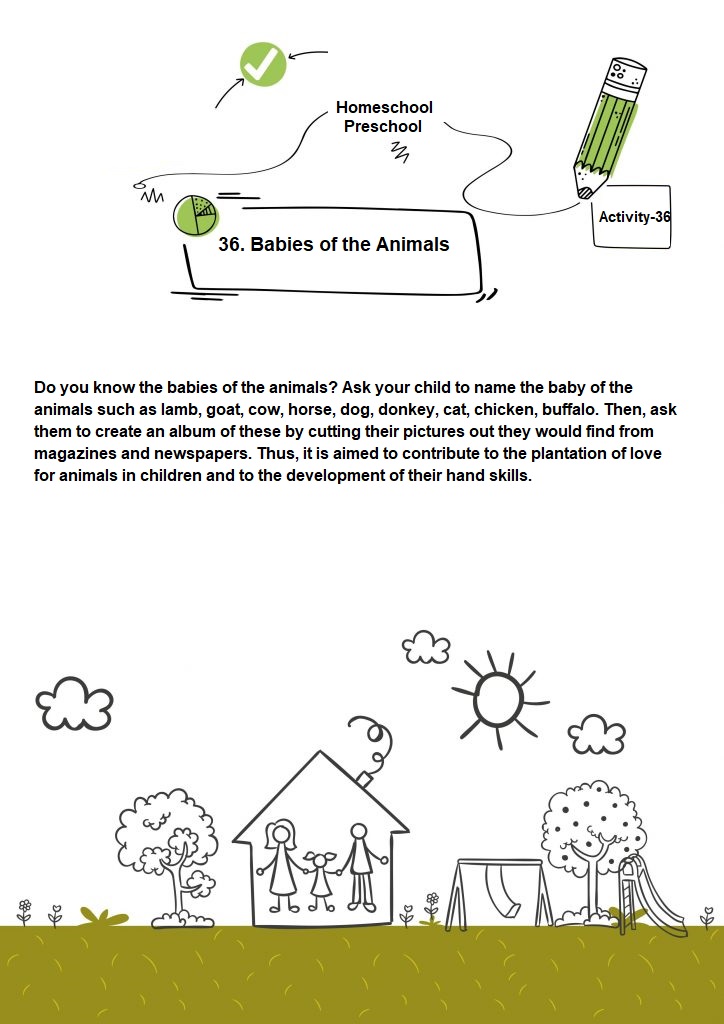
- Let’s Make A Spinning Top
Make a spinning top with your child. Make a hole in the cap of the plastic bottle. Then pass the matchstick through the center of the cap, make sure the brown part is at the underside. Try spinning the top you made with your child.
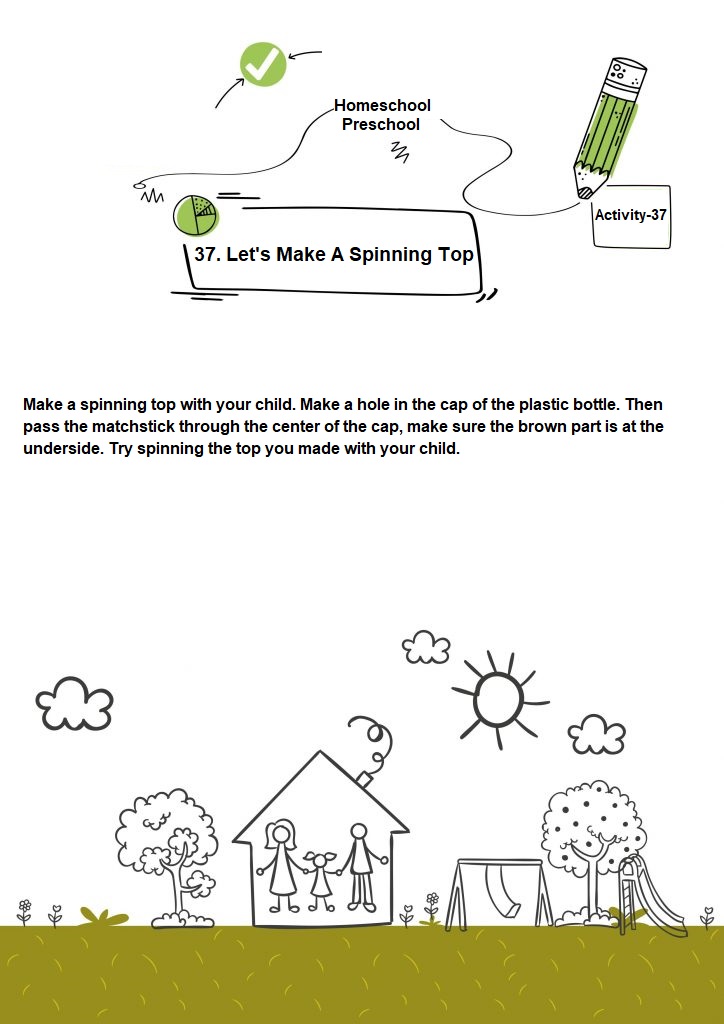
- Puss in the Corner
How would you like to play puss-in-the corner at your home today? Be the “it”, let family members stand in the corners and try to get the other corners without getting caught. The one who is caught is the next “it” and the game continues as such.
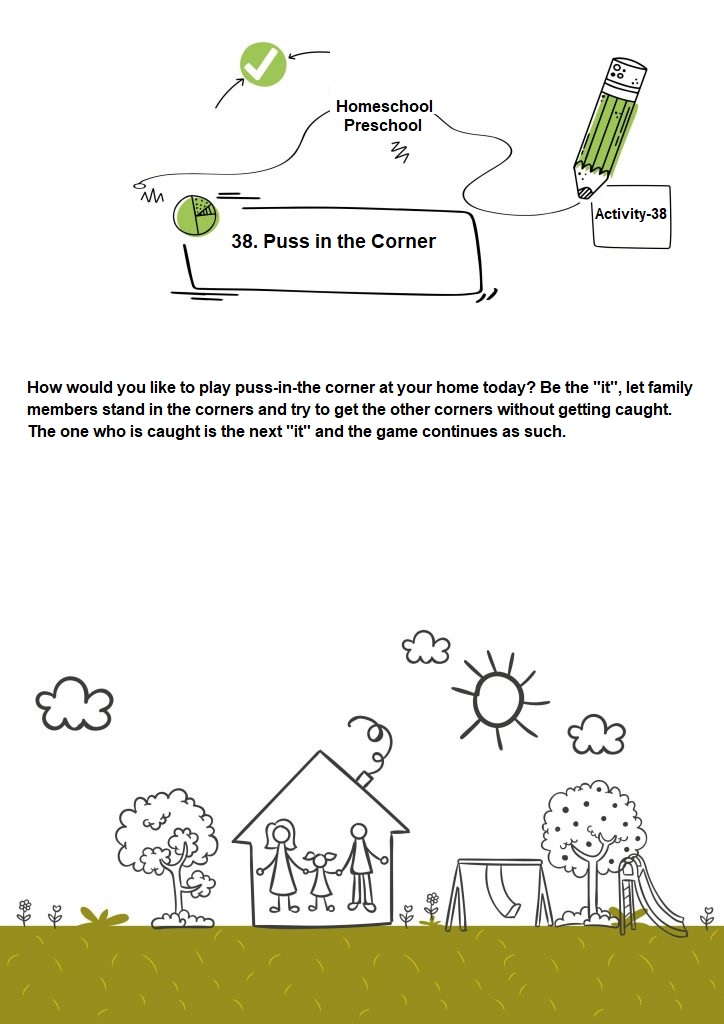
- What If It Weren’t…
Play “What if” game with your child. Think together what would it be like if there were no rains, no winds, no trees…
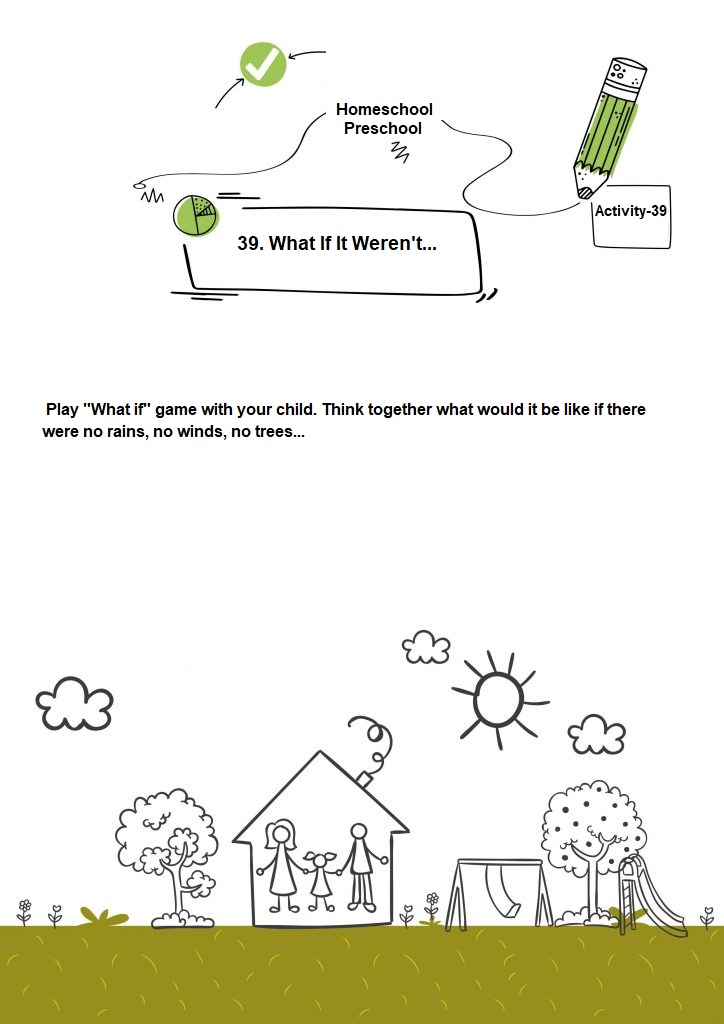
- Making Music with Our Body
Make music with your child by creating different sounds with your body. For example; clapping, slapping your knees with hands, hitting the floor…
Don’t forget to repeat the previous move each time a new one is made.
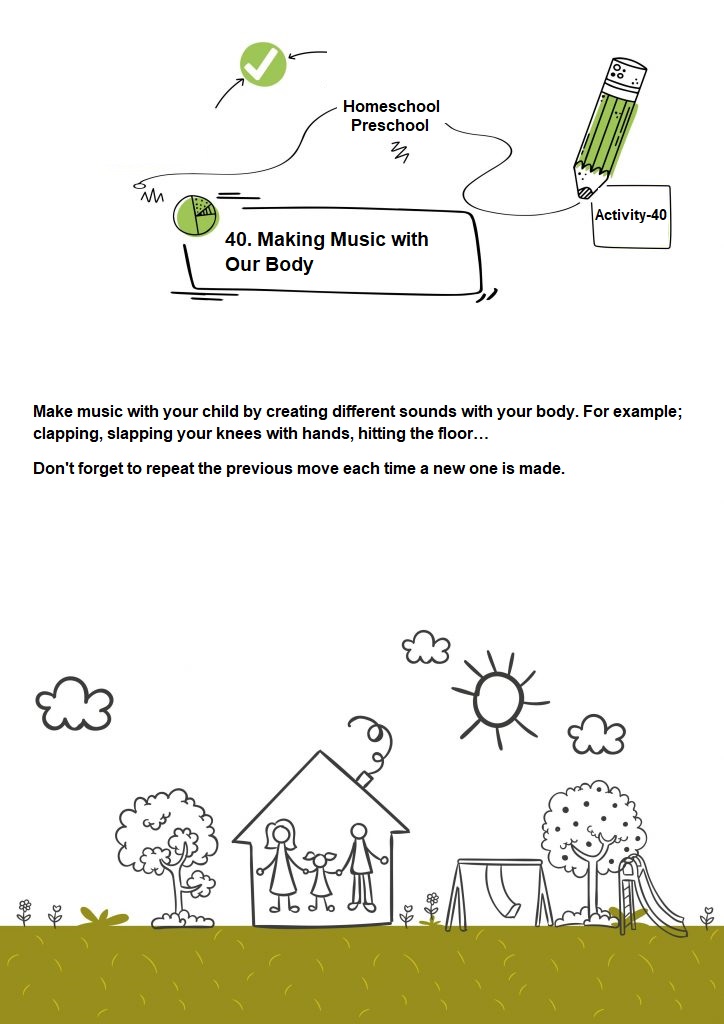
- Triangle Hunt
First of all, plenty ofdots are drawn on a paper. Then the player who is given the first turn draw a line between two dots. This line should connect two dots but should not touch to many dots. After this line, turn passes to another player. The purpose of the game is to construct a triangle by blocking the opponent with lines, for them not to make a triangle before you. Because of this, one must be careful while drawing lines. If someone somehow makes a triangle by connecting two dots, he or she write the first letter of their name into it. Thus, it becomes clear who the triangle belongs to. The aim in the game is to improve attention.
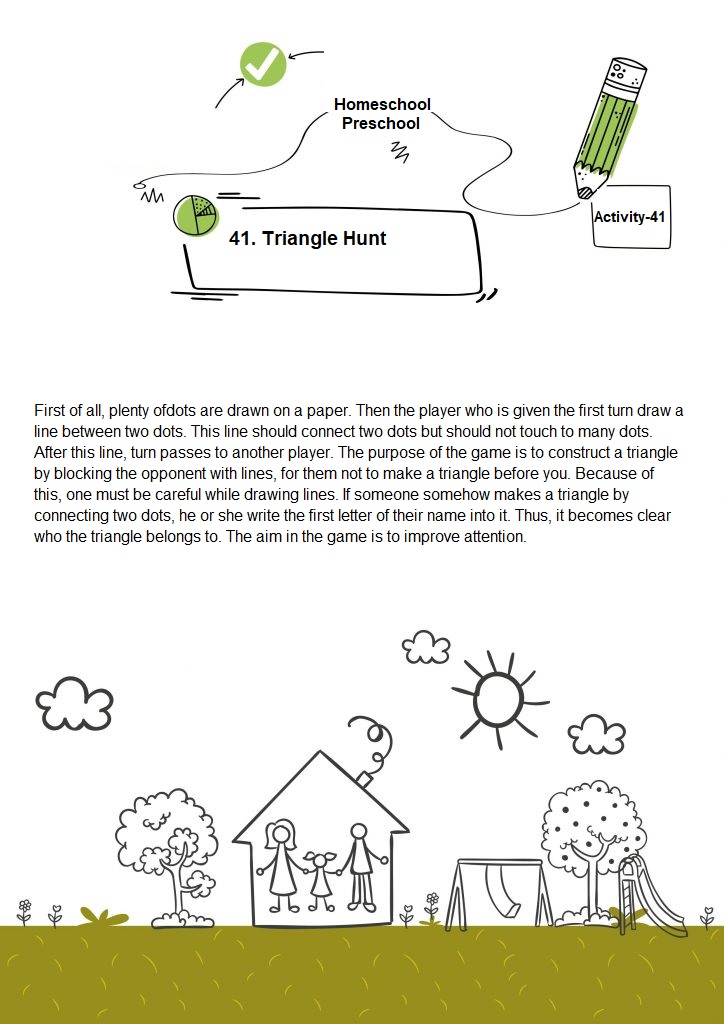
- Roly-Poly
A long stick is placed in the middle. One of the players holds the stick so that it stays standing. Players line up in a circle around the stick. Every player is given a number. The one in the middle says a number and unholds the stick. Then the one whose number is said tries to grab the stick without making it fall. The aim in the game is to imrpove motor skills.
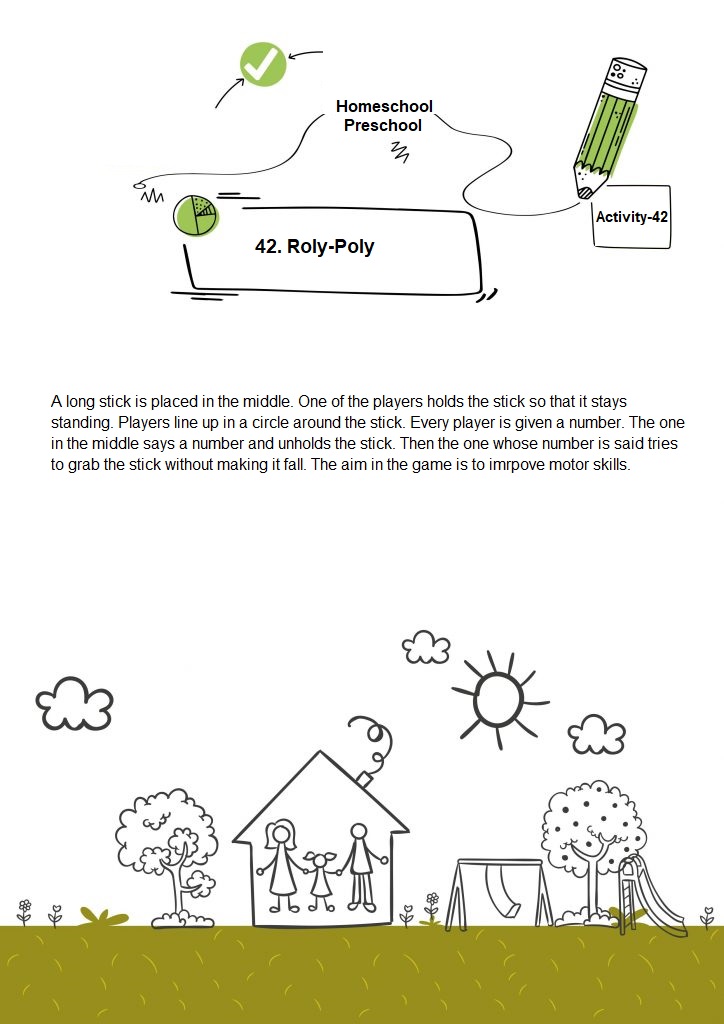
- I Went to Market…
Players sit in a circle. One of them starts the game by saying “I wen to market and bought apple.” The player next to him says the thing the previous one bought and adds another thing to it. For example; “I went to market and bought apple,banana.” Third player repeats the same the second one said and continues by adding another thing. The one who makes a mistake or forgets the order of the things that have been bought is out and leaves the game. Others repeat the game starting from the beginning. The aim in the game is to improve memory and vocabulary.
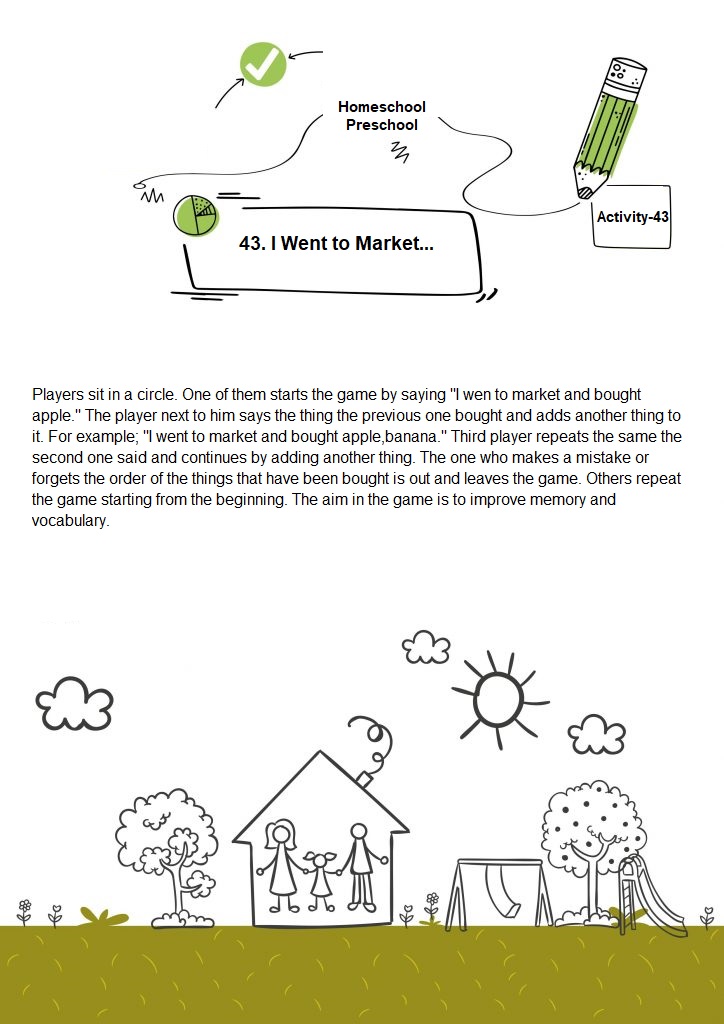
- Categories Game
Hold the paper horizontally and write down NAME-CITY-ANIMAL-PLANT-OBJECT and NOTE above it. A line is drawn from above to below after each word written. One of the players, starts to count the alphabet from inside. Then says out loud the letter he gets when it is said “Stop”. For example, if it is “M” everyone tries to come up with a name, city, animal, plant and object that is starting with “M”. The one who finishes first begins to count to 20. When it is 20, everyone gives up writing. The words that are left empty by the players count as 0 point. If two of the players have the same words, they would get 5 points. The ones that are different from one another get 10 points. At last turn, all points are counted up and the one who has the most, wins the game.
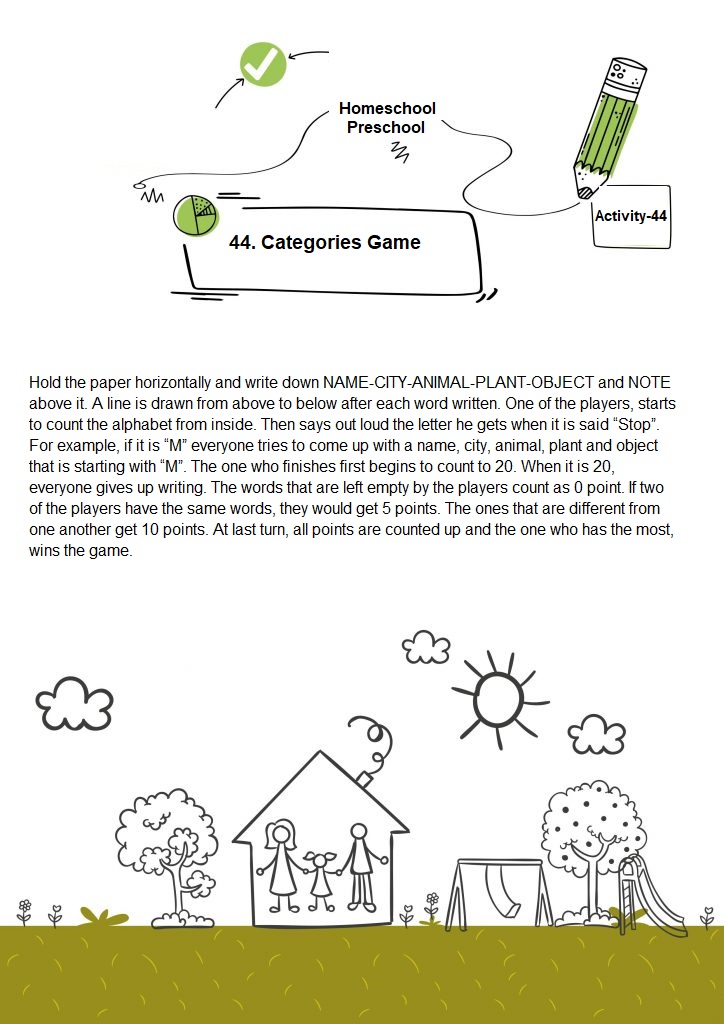
- Boom!
Players make in a circle. One of them starts counting and says “1”, the one next to them continues and says “2” and so on. The player coming to “5” says “boom” rather than “five”. According to the game rule, it is to be said “boom” for multiples of 5 and 10. For example, “1,2,3,4, boom, 6,7,8,9, boom”. The player who makes a mistake and says the number itself instead of saying “boom”, is out. The game goes on among other players starting from “1”. It is a game improving one’s attention.
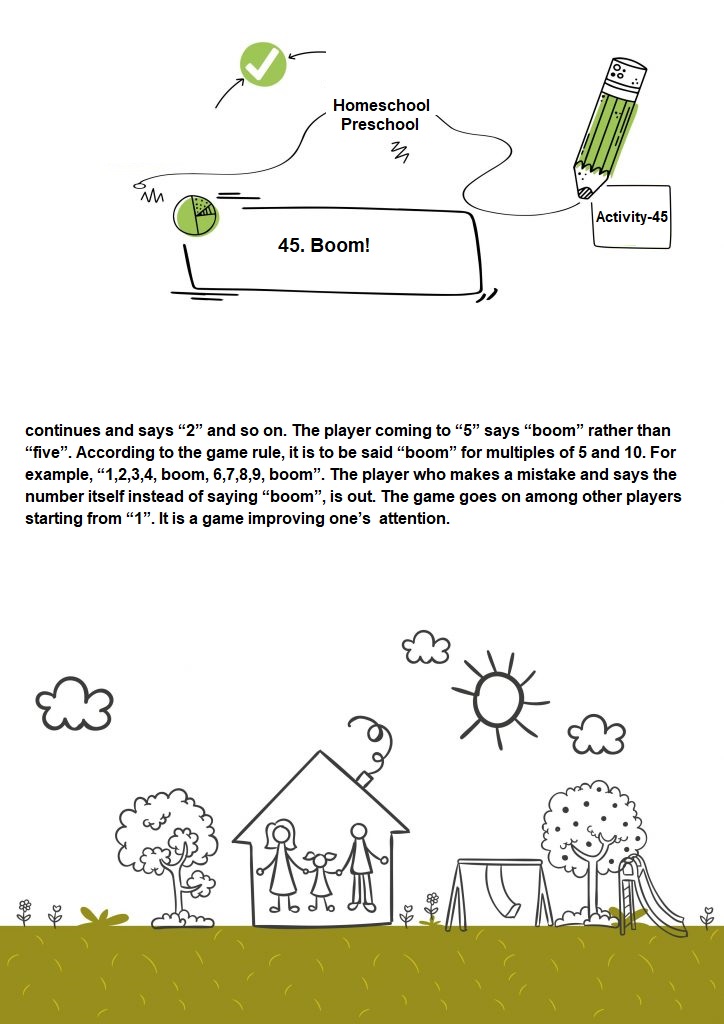
- Comparison Game
First player compares the other player with an animal or object. Then the other player compares the first one with another animal or object that is starting with the last letter of the thing he or she is associated with. For example “I am comparing you to a pencil” they say. The last letter of pencil being “L” is used by the other player to come up with another comparison. For example “I am comparing you to a lamb” they say. The game goes on until someone is out of comparisons. This is a game that improves quick and various thinking.
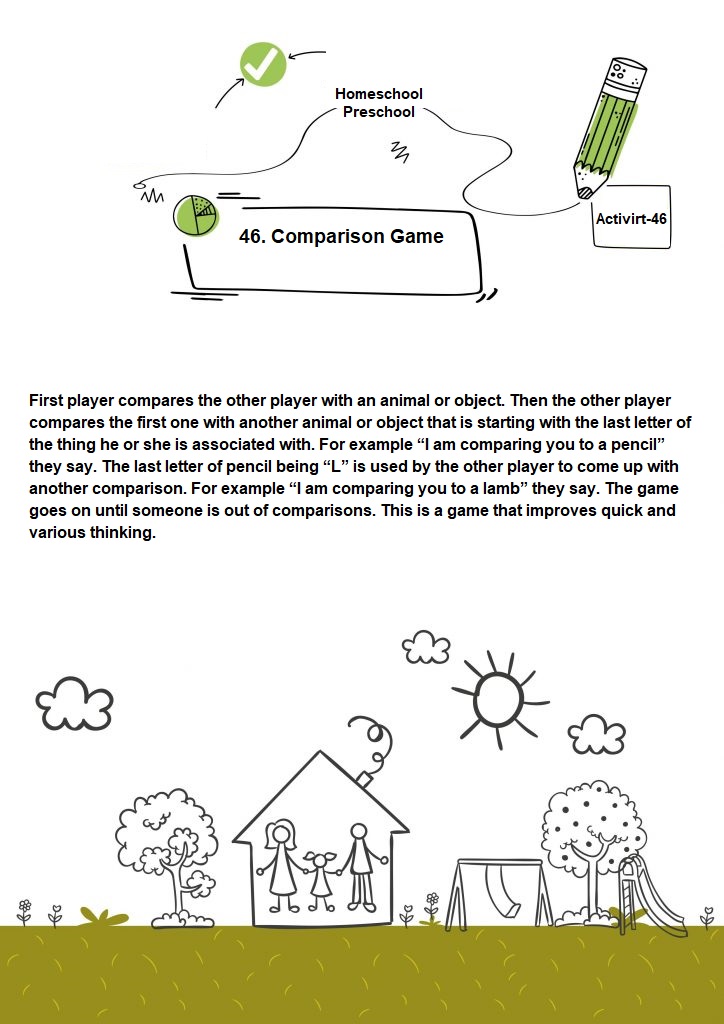
- What Do You Need?
Each player has 2 minutes for the game. First one chooses a job and starting the game by saying “What do you need?”. For example, “You are a doctor. What do you need?”. When the other player answers this question and continues the game by saying “What else do you need?”. The player has to keep answering “What do you need” questions qucikly for 2 minutes. The one who cannot answer before 2 minutes are up, is out. When a player finishes their question, the turn passes to other one and they maintain the game by choosing another job. The purpose of the game is to get to know jobs.
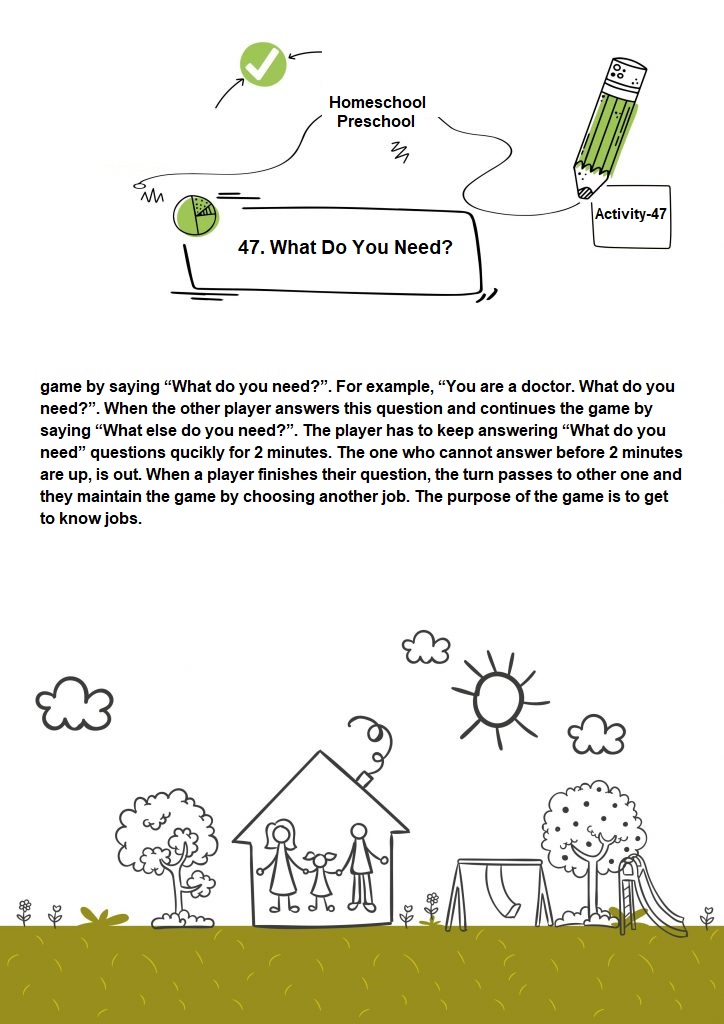
- Thinking of an Animal
One of the players thinks of an animal. The other ones ask questions about this animal. “How many legs does it have?”, “What does it eat?”, “Where does it live?”, “What color is it?” and so on. The animal is tried to be found by the other players according to given answers. The game goes on like this. The purpose is to get to know animals.
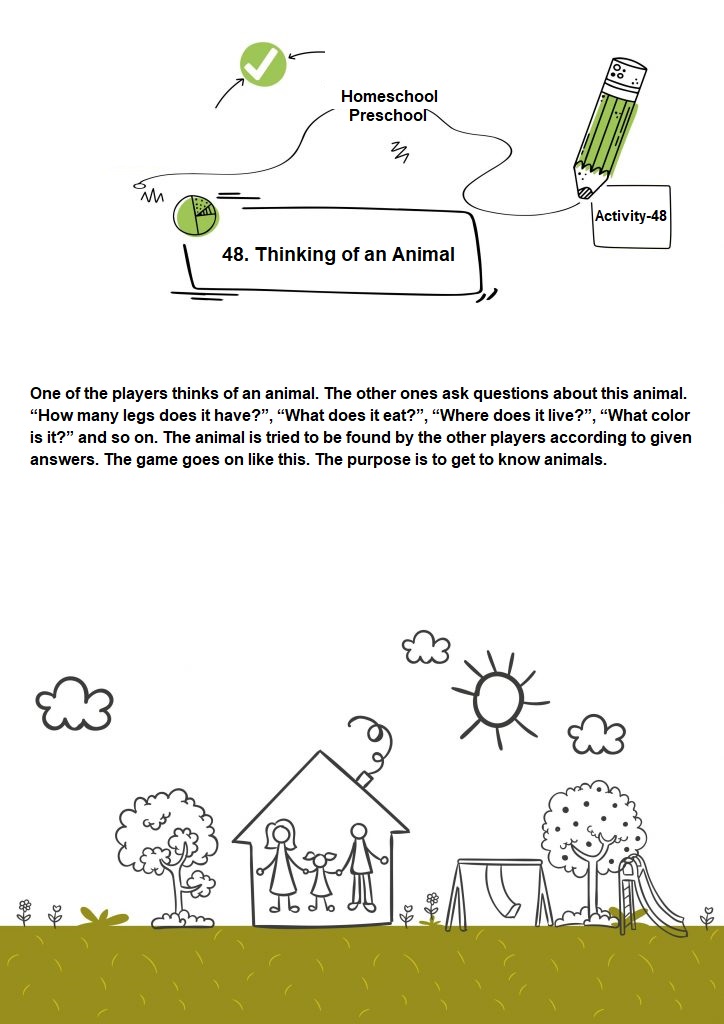
- Word Hunt
One of the players, or parents, give children a two-letter syllable. For example “el”. The children are asked to find out 3 or 5 words that starts with “el” in 2 minutes. Such words as “elephant, elbow, electric, elevator”. The one who gets the words of aimed number gets 1 point. The purpose in the game is to improve vocabulary and pronunciation.
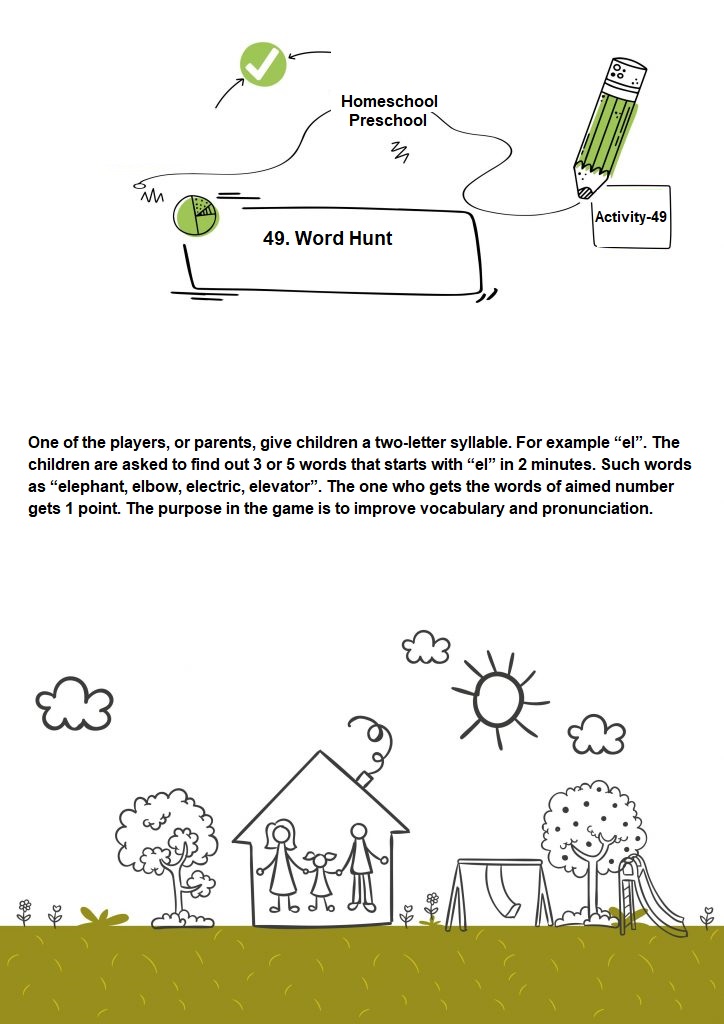
- Table Ball
The players are seperated into two groups and they gather around a table. Each group draws a line in front of them to mark their space. A ball of cotton is put in the middle of the table. With the starting call, players blow to the cotton to make it cross the line of other group. For each piece that is blown up to the marked point, 1 point is given. The group who gets 5 points in total wins the game. The game improves the skills of planning in the visual-spatial area, of concentrating and of acting quickly.
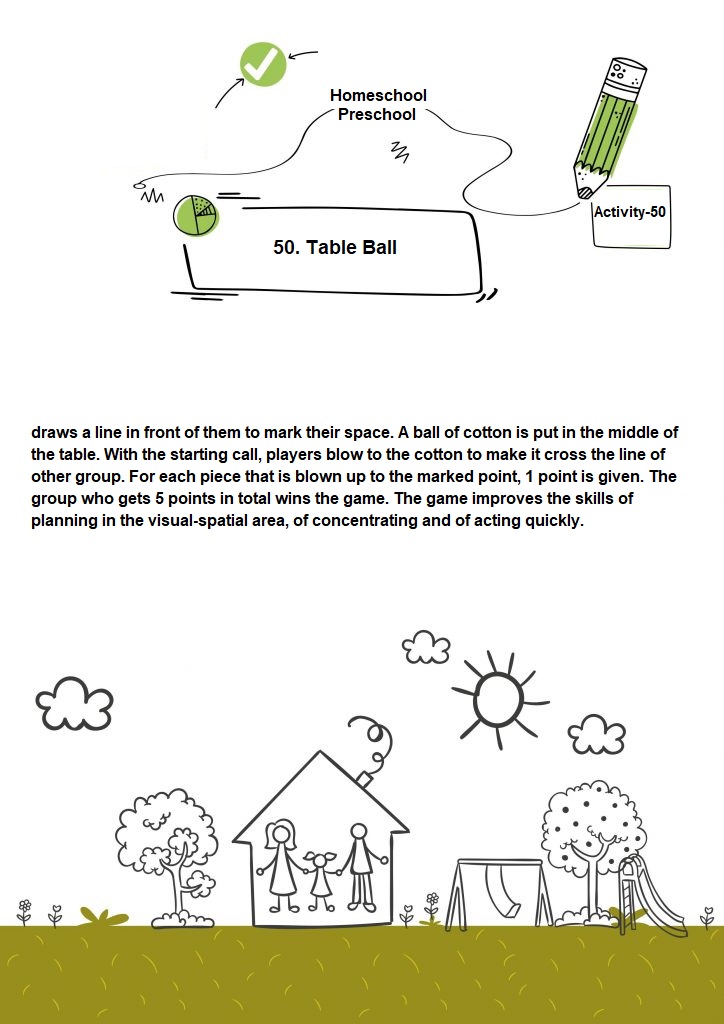
- Sculptor
One of the players is chosen as sculptor. The sculptor tells that he would like to express different things in his work. For example; “I would like to make the cutest, the most horrible and the most happy one of the sculptures”. As soon as he says this, players are to pose and make a face according to the wishes of sculptor. The one that is most liked by the sculptor becomes the next sculptor. The game improves the concentration, skills of following the directives, psychomotor speed of development, gross motor skills and ability to express emotions.
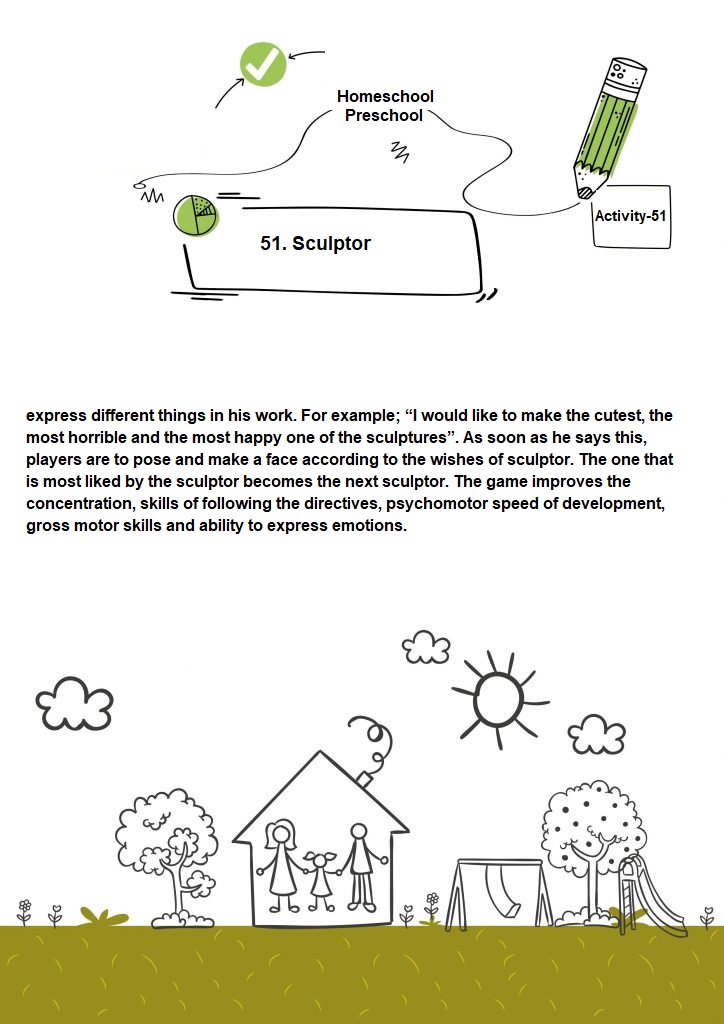
- Touch and Guess
Objects in the home are put into a tray. (Hairbrush, coins, wallet etc.) the tray is covered with a piece of cloth after all the players take a look at these objects for a short time. The players try to guess the objects by touching one by one. The game improves reasoning and areas of short-term and active working memory by using the sense of touch.

- Bouncing into the Plastic Cup
Two coffee tables are put in front of the players. A plastic cup is put on the farther table. Player tries to basket the ping-pong ball into the cup by bouncing it to the closer table. The first one to have the ball into cup wins the game. It can also be played by competing of at least 2 players or by timing. The one that finishes before wins the game.
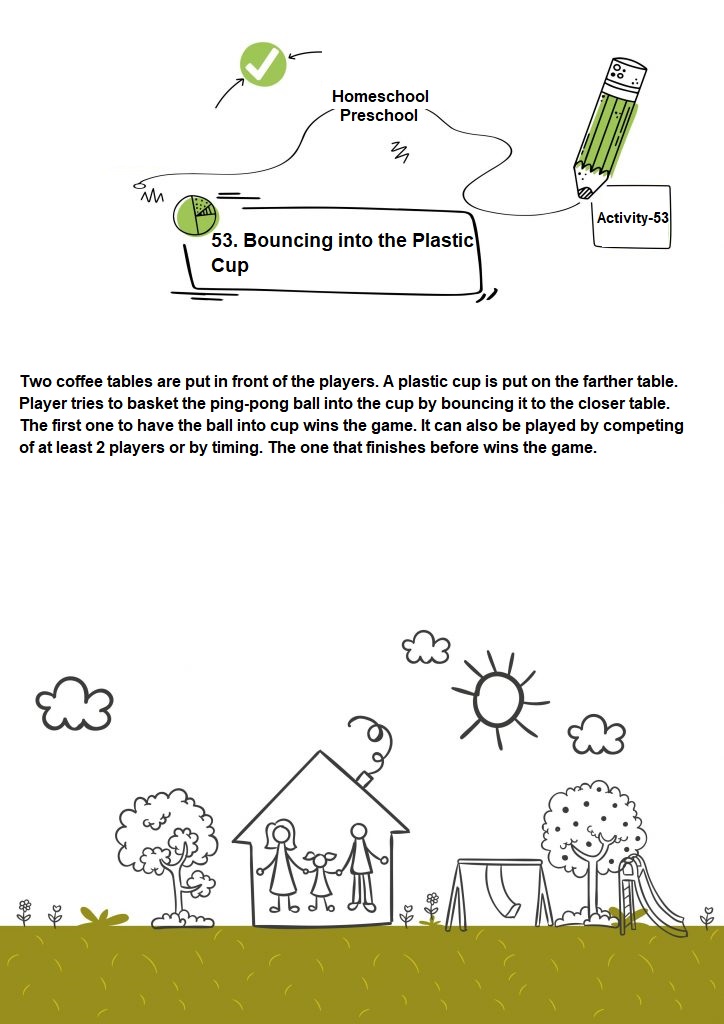
- Walk Like Me
Each child is asked to do an imitation walk. If the child successfully performs this walk, he/she is applauded by their friends. This is a game to improve observation and the skill of better use of the body.
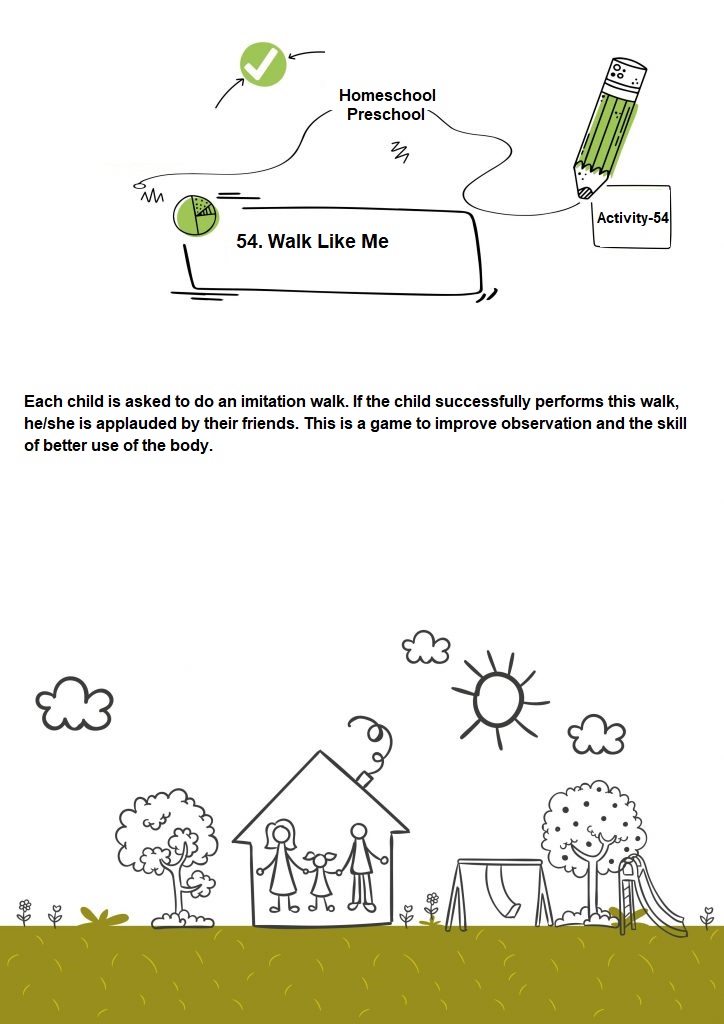
- Hot-Cold
Someone is selected as “it”. Then an object is chosen to hide. “It” leaves the area and other ones hide this object together. Task of “it” is to find this object. Other kids direct him by saying “hot” if he is close to the object and “cold” if he is far. When he finds the object, he chooses another player to be “it”. It can also be played by giving “it” a limited time. For older children, the number of hidden objects may be increased. The game improves perception of distance, attention and skills of reaching the end by following the directives.
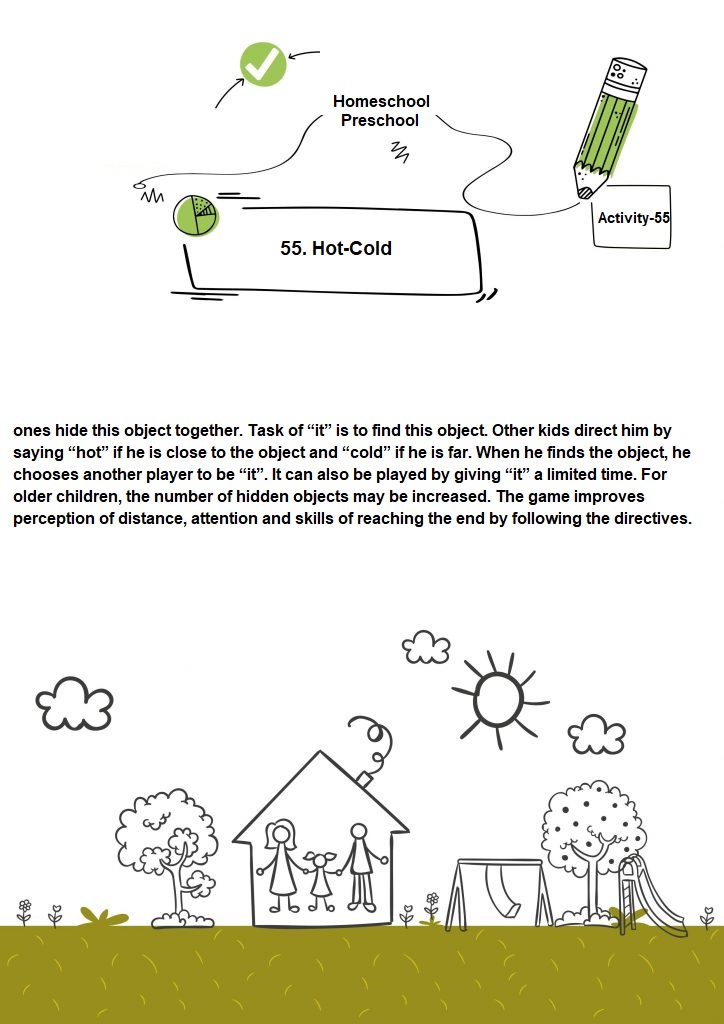
- Heads Down, Heads Up
It’s a fun game that can be played with many players including at least 5. Everyone is given a special funny name in this game. For example, one of them is called pumpkin, the other one is called potato, the other one is carrot, the other one is bean et cetera. Let’s say pumpkin starts the game. Other players are to put their heads down on the table. Pumpkin calls one of his friends’ name, carrot for example. He says “Pumpkin down, carrot up”. When pumpkin puts his head down, carrot should be up now. For this time, he says “Carrot down, potato up” and the game goes faster and faster. It improves attention and gross motor skills.
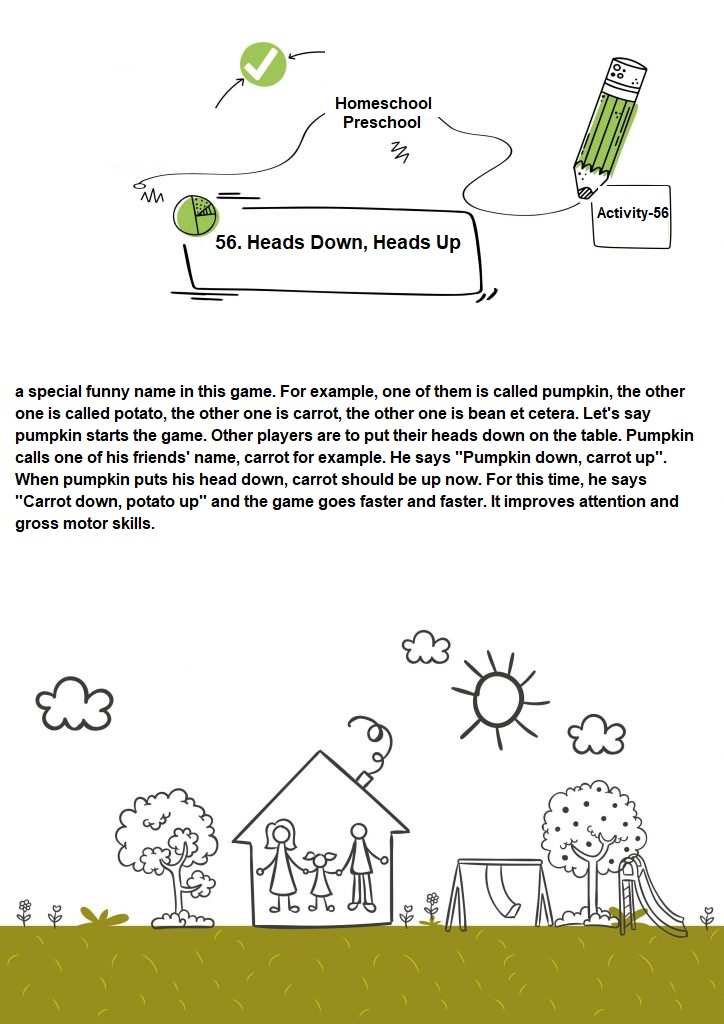
- Fly Bird Fly!
This game can be played at home or in class. Players gather around a table. An “it” is chosen and he/she sits face to face with other players. Then he/she says “Fly bird fly!” and raises their finger. Everyone has to raise their fingers since “it” says something that can fly. “It” then says something that cannot fly like “Fly chicken fly!” and raises their finger again. However, other players are not to raise their fingers since chicken cannot fly. The player who makes mistake and raises finger is out. This game improves attention skills.

- Boom-Fizz
Players make in a circle. One of them starts counting and says “1”, the one next to them continues and says “2” and so on. The player coming to “5” says “boom” rather than “five”. According to the game rule, it is to be said “boom” for multiples of 5 and 10. This time as an addition, “fizz” is said for multiples of seven. For example “1, 2, 3, 4, boom, 6, fizz, 8, 9, boom, 11, 12, 13, fizz…” and goes on like this. The most important part of the game is to be cautious for the common multiples of 5 and 7 like 35,70,105 and to say “boom-fizz” in these numbers. The game can be continues from 1 to 100. It can be played up to higher numbers if desired. The game improves attention and operation skills.
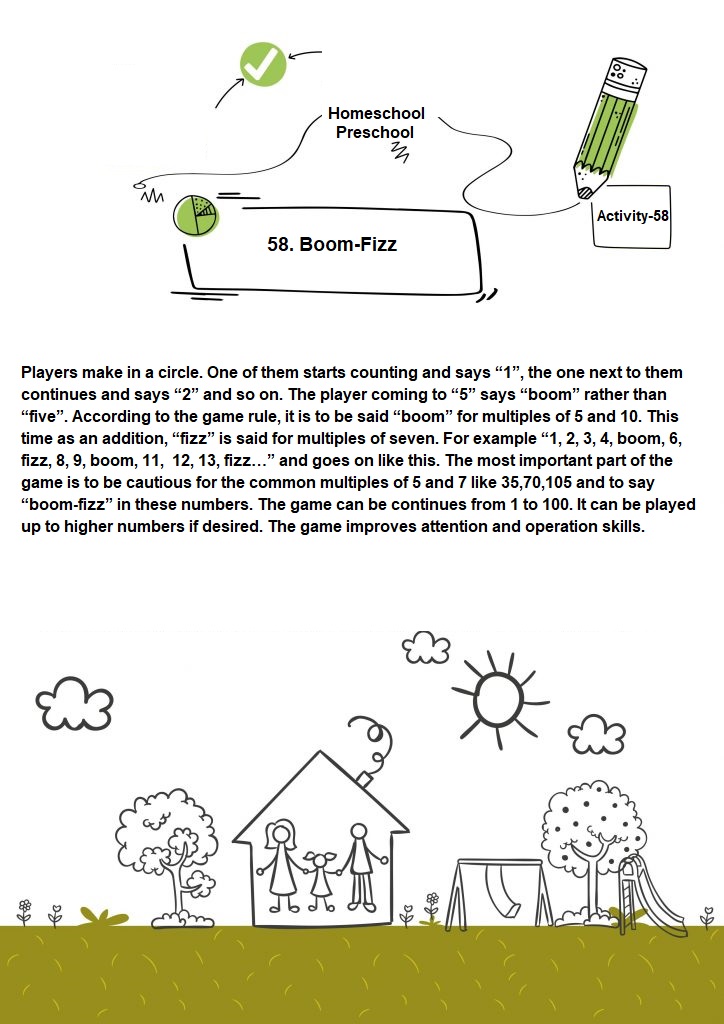
- Increasing Comparison Game
This game includes the basic rules of classical comparison game. That is, players compare each other with an animal or plant by using ending letter of the word. For example, if the first player says “I am comparing you with a cat”, the other player is to come up with another thing starting with “t”. The difference in this game is to begin with a word that has fewest letter. If it starts with “cat” for example, the next word should include 4 letters. It might be said “tape”. Then we now need a 5 letter word starting with “e”.The game goes on to the point when the word with the most letters is reached. The player who cannot come up with a word that has required letters is out. The game improves quick and different thinking.
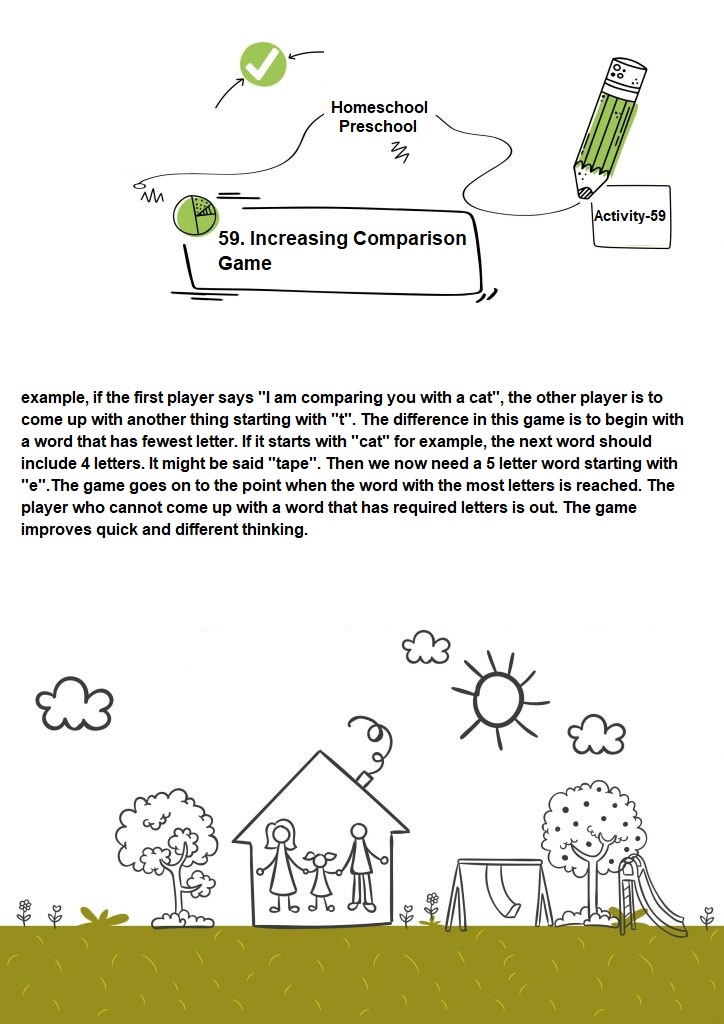
- Changing the Vowel
In this game, the vowels of the words used in our daily lives are tried to be said with another vowel chosen. For instance, one of the players is asked to …. days of the week by using “a” only. That is, he/she has to say “manday” to monday, “taasday” to tuesday and so on. It is checked if he/she …. correctly. Months of the year, vegetables or other word groups can be used in this game. The game improves quick and different thinking.
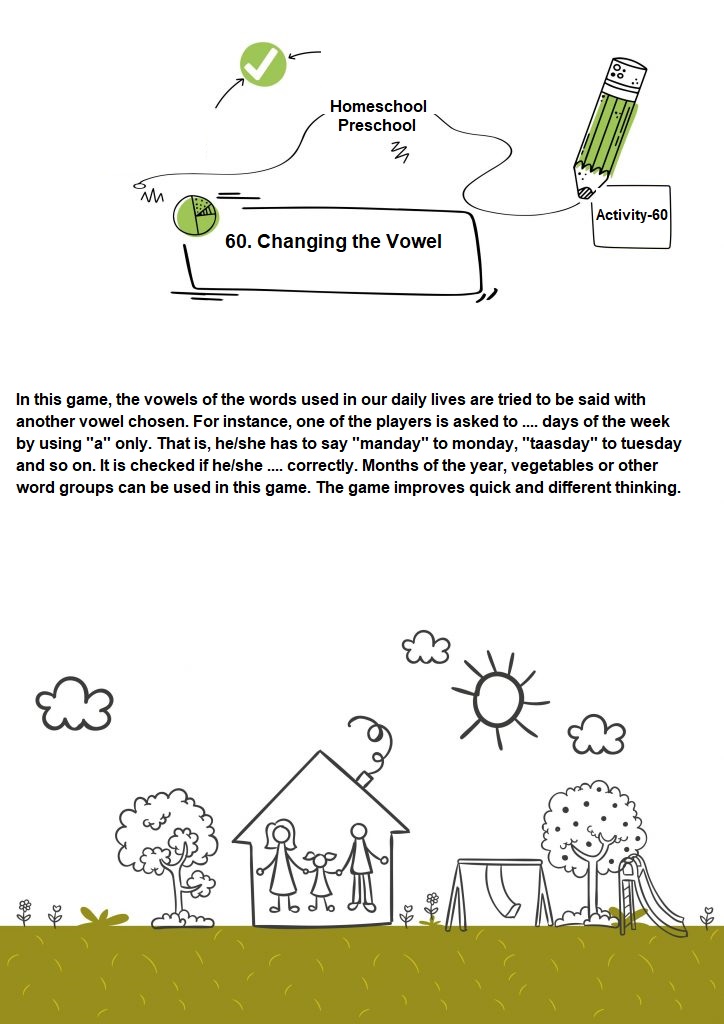
In these tough days that we have been going through Coronavirus, this great work will make your day at home more fun. These activities that includes all steps of education, can be enriched by you too. Please do not forget to reviewour website for other great Preschool Activities.

